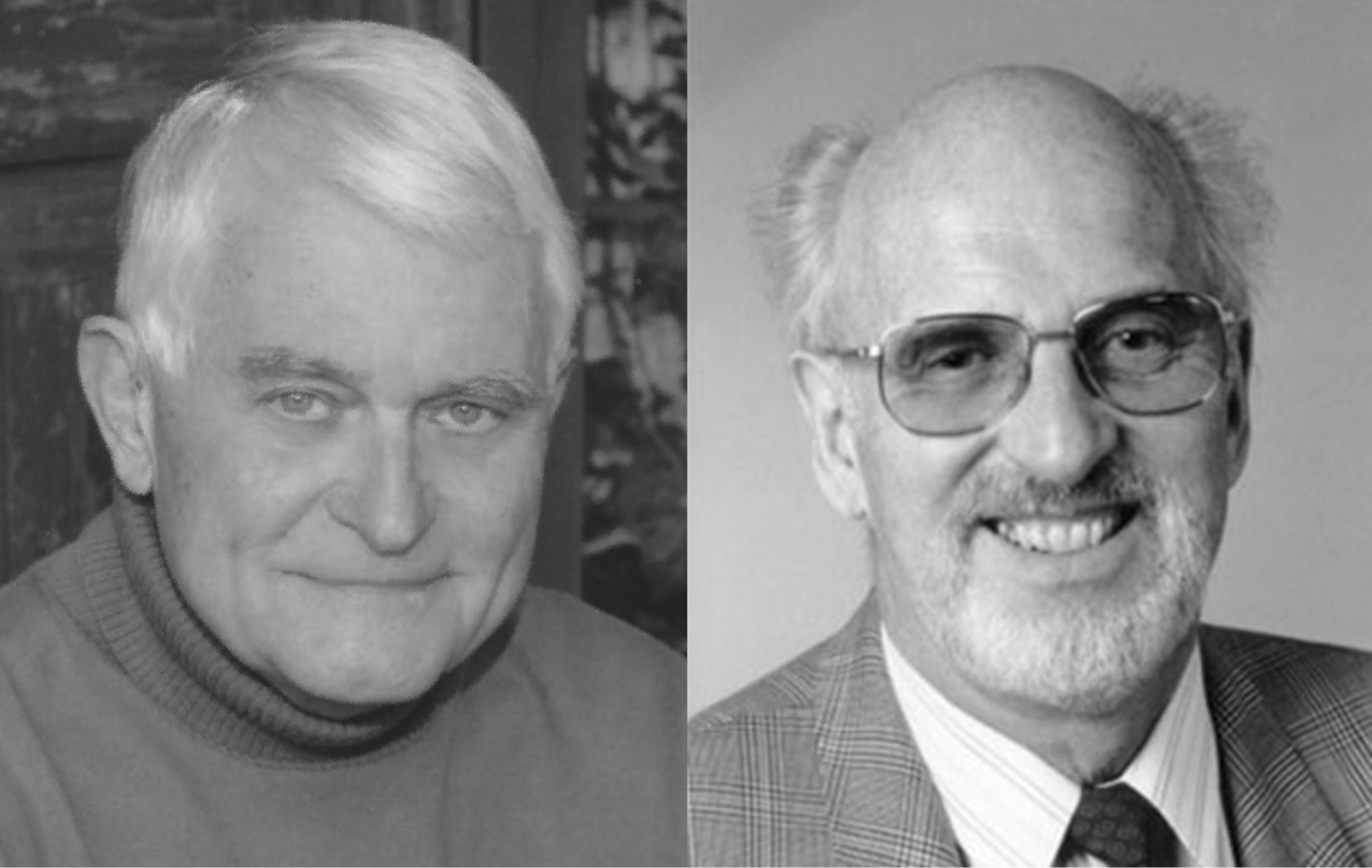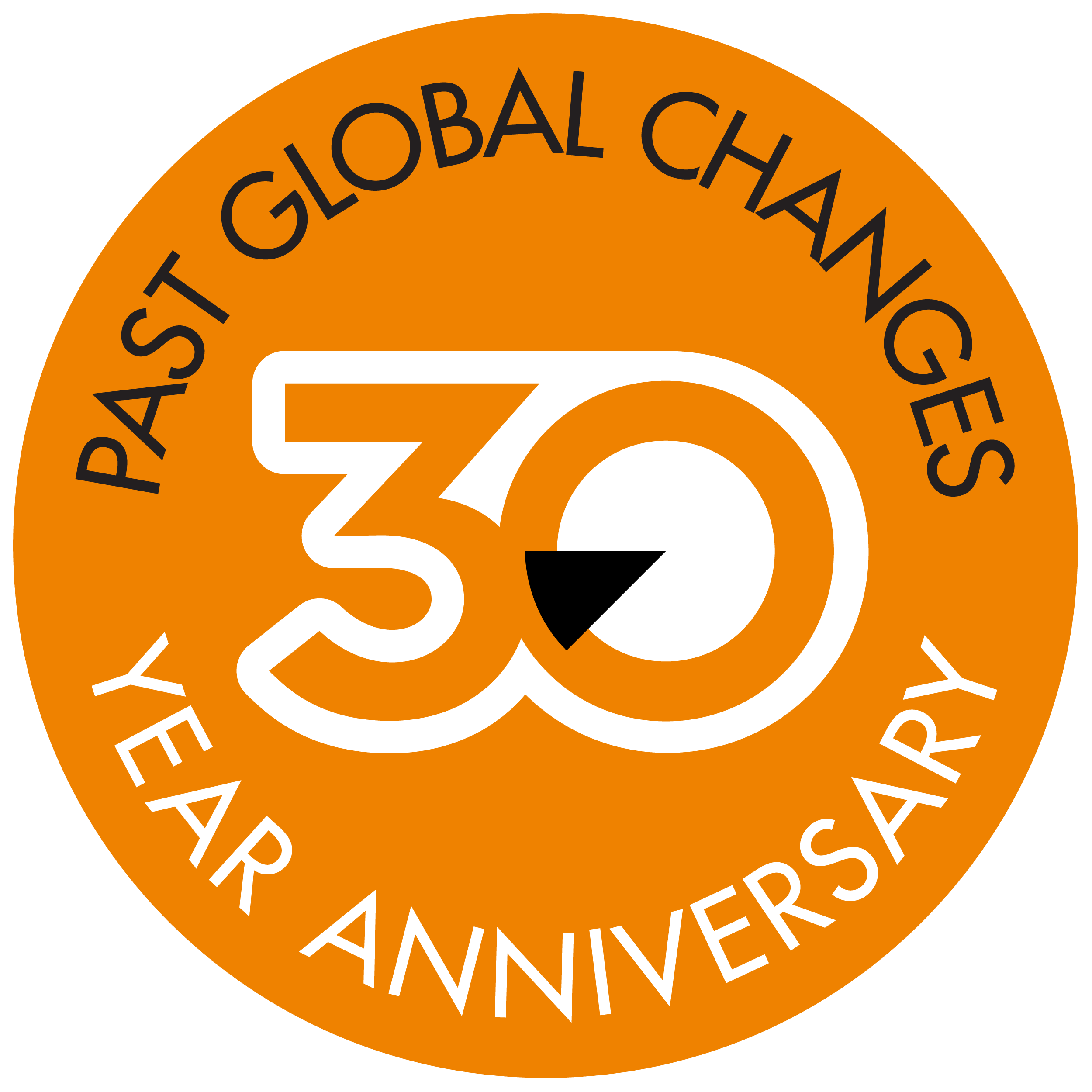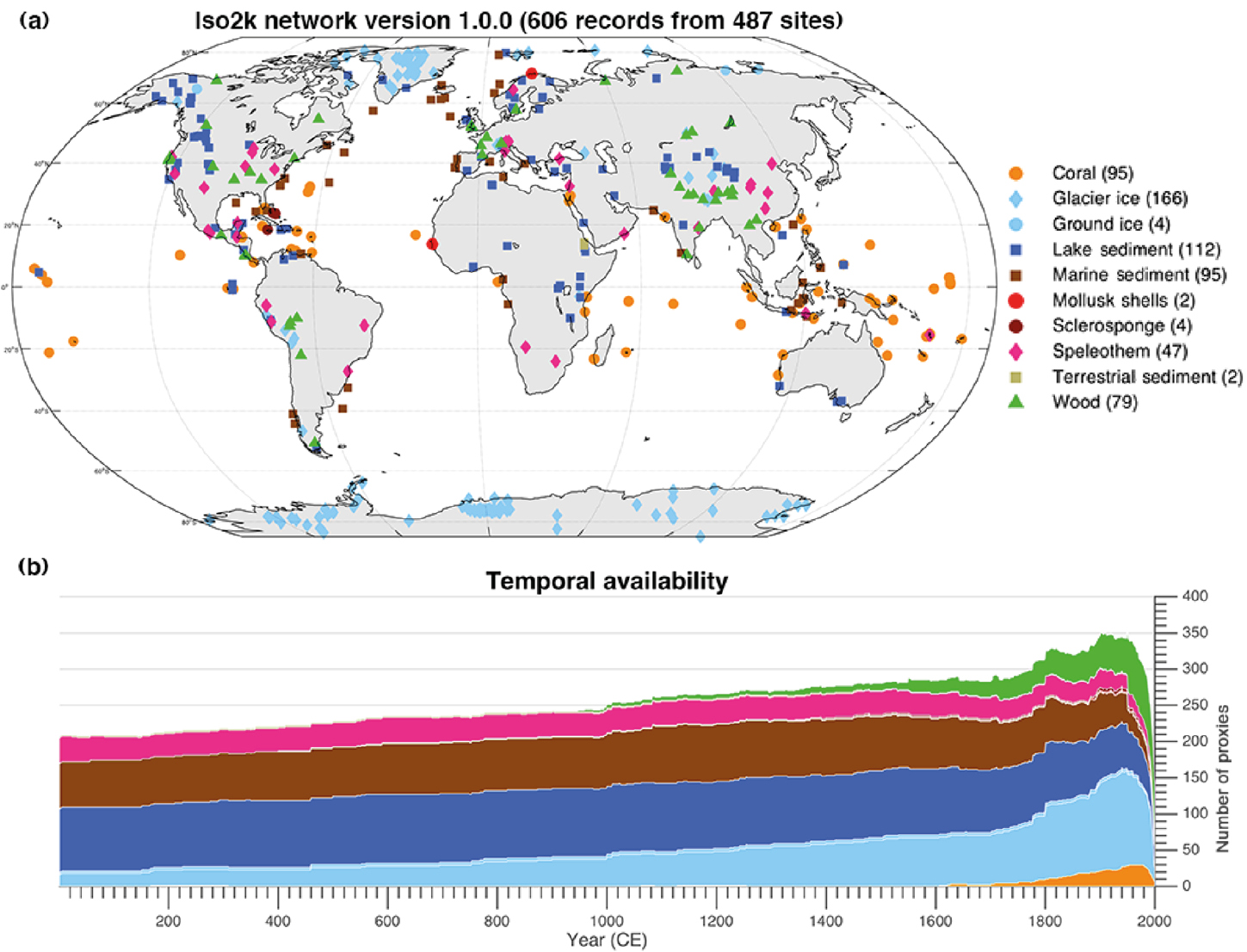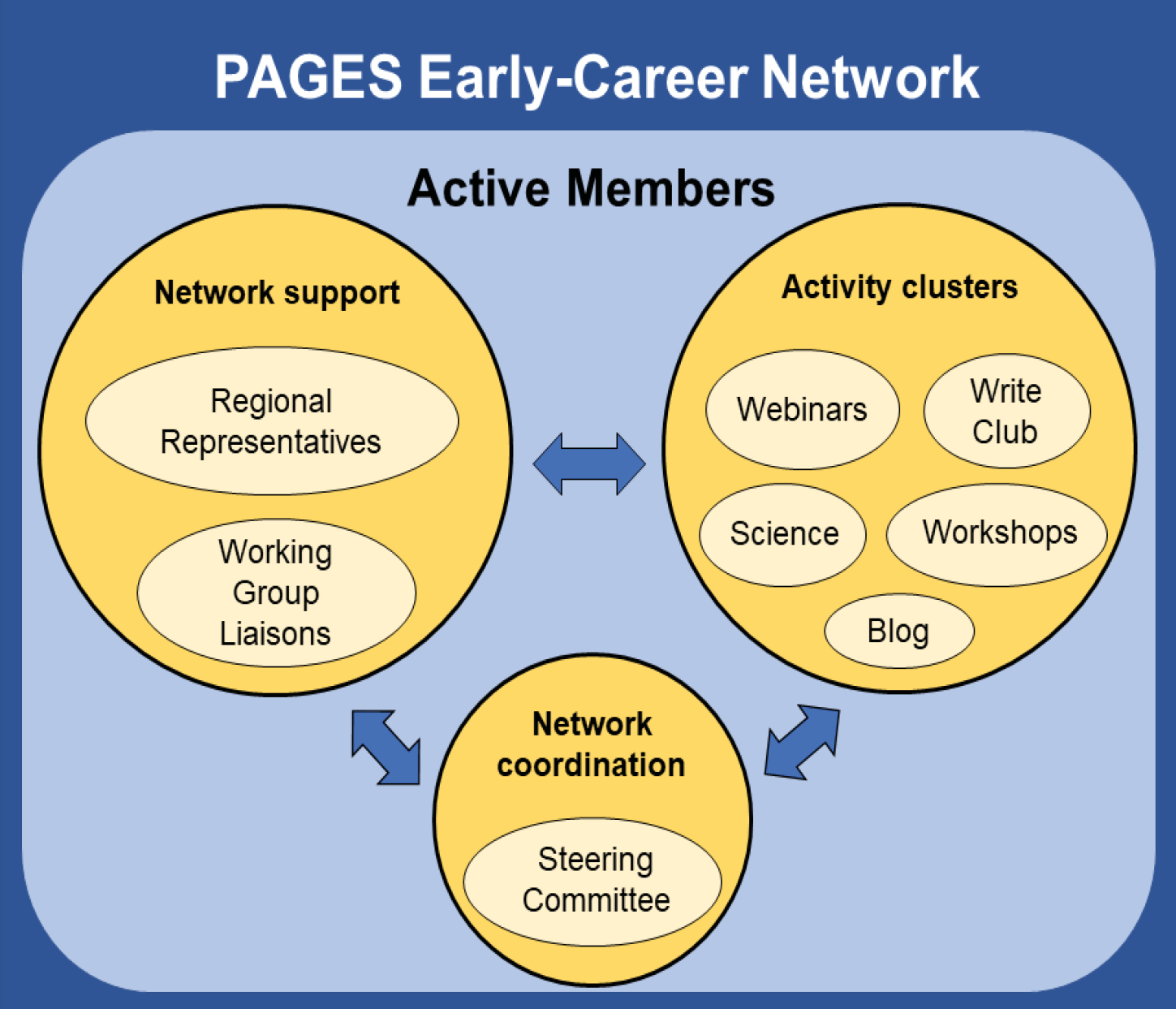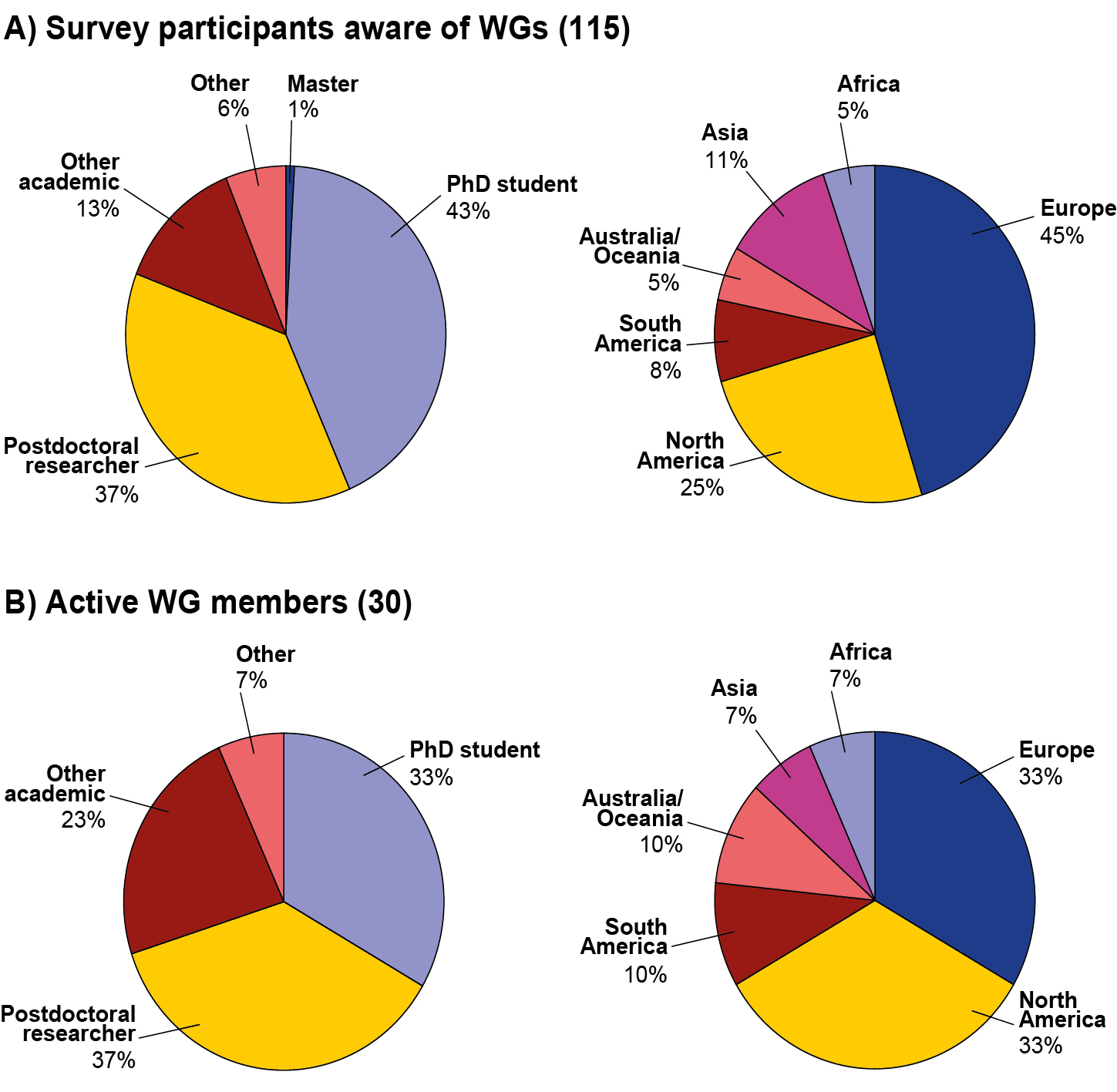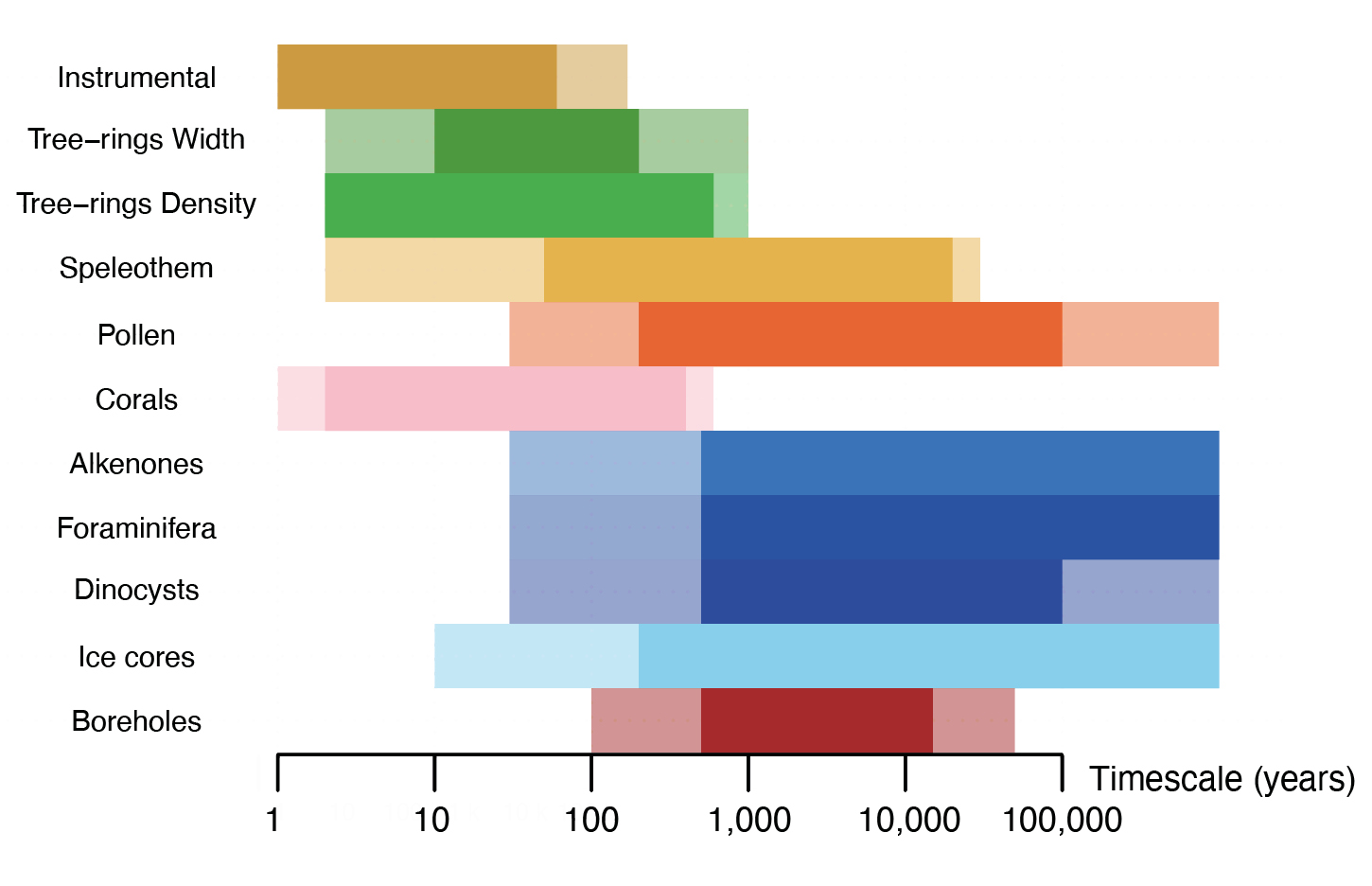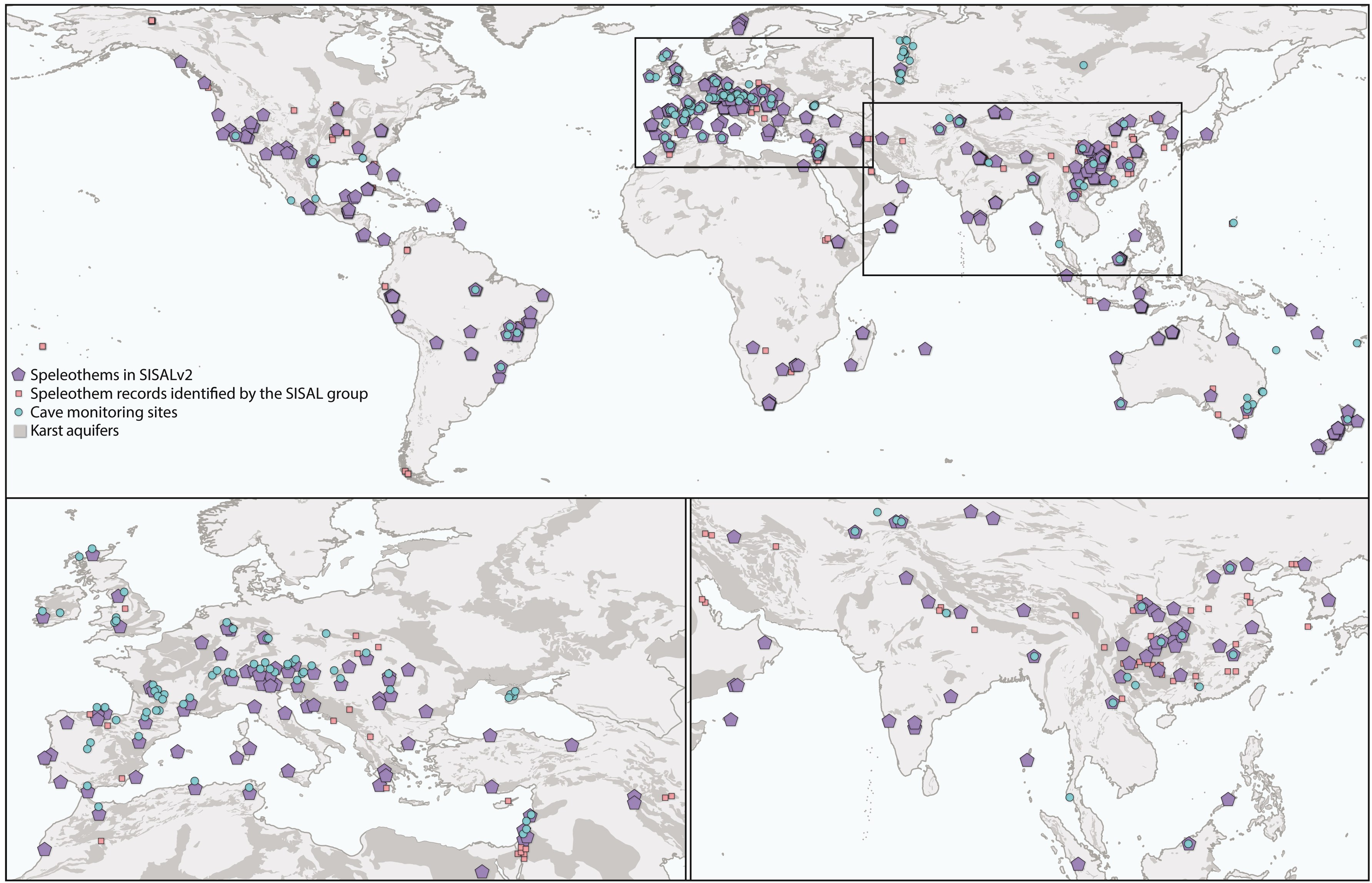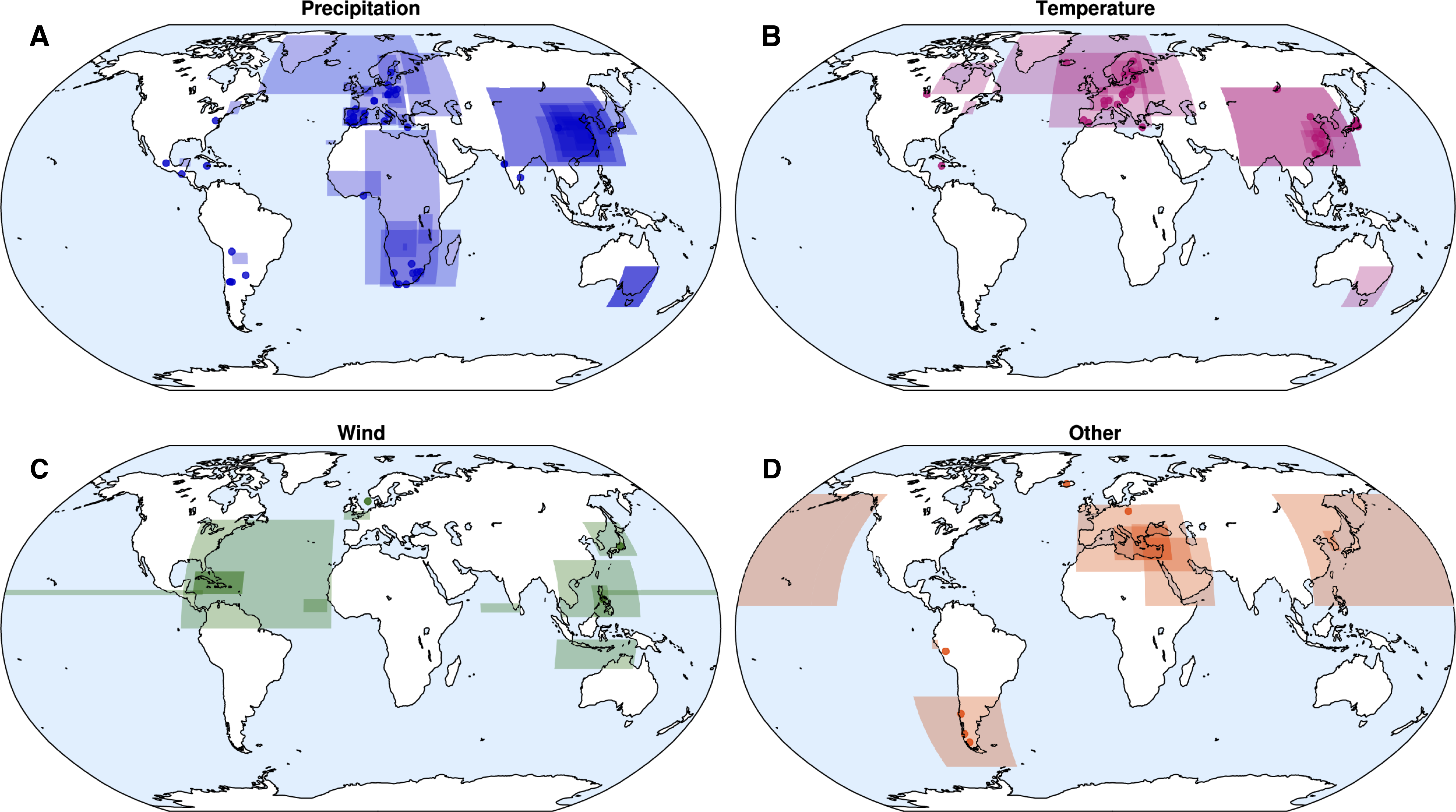- Home
- Taxonomy
- Term
- PAGES Magazine Articles
PAGES Magazine articles
Publications
PAGES Magazine articles
2021
Past Global Changes Magazine
Without the reconstruction of past global changes and the knowledge of the processes that control them, future long-term alterations in components of the Earth system cannot be reliably predicted. Over the last three decades, PAGES has dedicated its work to provide this information to the global science community.
Early visionaries
In 1972, the Club of Rome published its first report on "The Limits to Growth" (Meadows et al. 1972). It received substantial public attention and raised awareness that our use of global natural resources at an ever-increasing speed is not sustainable and that planetary boundaries set limits to economic growth. At the same time, more and more scientists across the globe engaged in quantifying the ongoing human impacts on climate and the environment, improving our understanding of the Earth system, and implementing these processes in Earth system models to predict Earth's future evolution. In the decades following the Club of Rome report, the International Council for Science (ICSU) and the International Social Science Council (ISSC) initiated four global programs to organize the huge task of global change research: the World Climate Research Programme (WCRP), quantifying physical changes in the climate system; the International Geosphere-Biosphere Programme (IGBP), studying changes in biogeochemical cycles; DIVERSITAS, concentrating on changes in biodiversity; and the International Human Dimensions Programme (IHDP), addressing the impact of these changes on human societies and their well-being.
Some early visionaries from the paleoclimate field immediately realized that documentation of contemporary changes alone was not sufficient to assess the impact of human interference with the Earth system, particularly because many components of the system act on timescales much longer than the era of direct scientific observations (which are typically limited to a few decades or, in some cases, a few centuries). Some examples of such long-timescale components include glaciers and ice sheets, natural biogeochemical cycles, ecosystems and food chains, or ocean circulation. Most importantly, these are also all components that are crucial for the robust long-term prediction of climate, greenhouse gas forcing, and ecosystem response. Moreover, they are key to assessing the impact of anthropogenic changes on human well-being, which is affected by processes such as sea-level rise, water supply/desertification, heat waves and other extreme events, ecosystem structure and function, or agriculture.
Among the early visionaries in the early effort to incorporate paleoperspectives into global change studies were John A. (Jack) Eddy, a US solar scientist, and Hans Oeschger, a Swiss climate physicist (Fig. 1), who together chaired a special IGBP working group on "Techniques for Extracting Environmental Data from the Past". This working group met for the first time in 1988 in Bern, Switzerland, and included a "who's who" of paleoclimate researchers at that time. It was not an easy feat to assemble all those illustrious names in one room and to glue them together to work towards a common goal, but Oeschger and Eddy succeeded. Only a year later, an even larger workshop was organized in Snowmass, Colorado, USA. Those were the "good old times" when all participants were paid to attend, and it certainly helped in bringing the brightest "paleominds" together. The Snowmass workshop led to the report "Global Changes of the Past" (Bradley 1989) and may be regarded as the birth of PAGES, the IGBP Core Project on Past Global Changes. PAGES was officially launched two years later in 1991, with the goal to use the paleorecord to inform the global-change debate on long-term changes, processes, and risks in the Earth system.
An achievement just as impressive as bringing a large part of the paleocommunity together within PAGES was that Eddy and Oeschger managed to convince both the US National Science Foundation (NSF) and the Swiss National Science Foundation (SNF) to jointly fund the endeavor, including a dedicated project office in Bern. Unfortunately, Jack Eddy had to step down for personal reasons soon after the inauguration of PAGES, but Herman Zimmerman, program manager at the NSF, was so convinced of the PAGES cause that he stepped in with great enthusiasm as PAGES Co-Director, together with Hans Oeschger, and also spent a significant amount of time in Bern to help run the office.
The first PAGES Science Plan (PAGES Scientific Steering Committee 1994) was structured both geographically and temporally along three pole-equator-pole (PEP) transects. It concentrated on the last 2000 years and multiannual to decadal variability, as well as the longer timescale of the last glacial/interglacial cycle. This was a structure that "still makes my head spin", said Herm Zimmerman recently. Despite, or likely also because of, this multidimensional structure, a large part of the paleoscience community immediately joined this endeavor, helping to make PAGES an IGBP showcase.
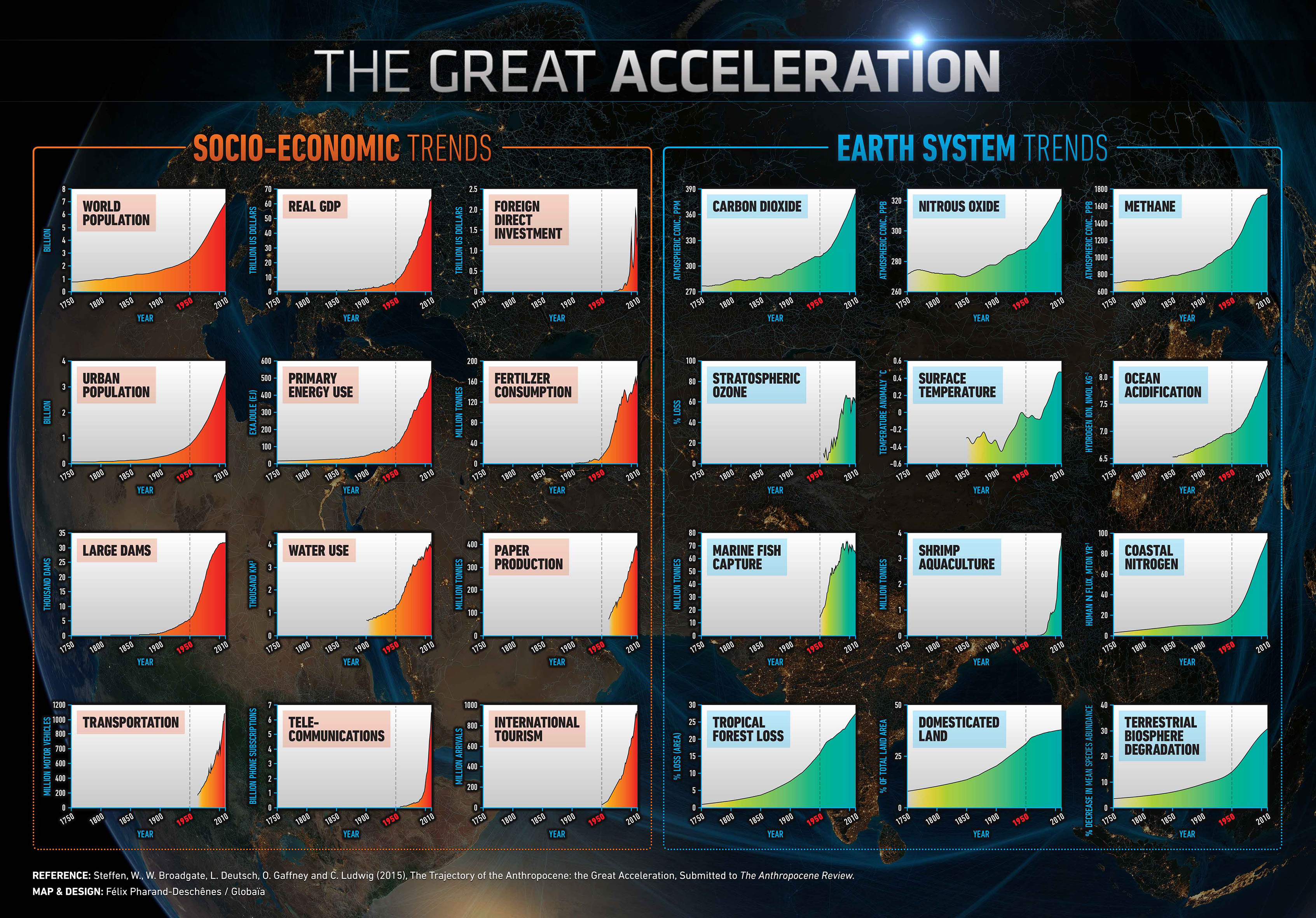 |
|
Figure 2: The great acceleration plot showing the rapid changes in socio-economic (left) and Earth system parameters (right) over the last 150 years (Steffen et al. 2015). |
With a spirit of being open to all participants, PAGES soon provided unrivaled integrated datasets as well as new insights into the Earth system that could not have been achieved without paleoscience and the large-scale syntheses that PAGES facilitated; a modus operandi that continues today. It is fair to say that the long timescales of change that are central to the work of PAGES are also at the heart of the notion developed in IGBP that we live in the time of "The Great Acceleration" (Steffen et al. 2015), as many of the Earth system trends displayed in the IGBP Great Acceleration Plot (Fig. 2) could not have been quantified without paleoresearch. The long-term changes in the Earth system caused by humans in the course of the (late) Holocene are also the reason for the ongoing discussion to define this time as a new geological era, the so-called "Anthropocene", where geological evidence is overprinted by human actions.
The success of PAGES and especially of its innovative working groups clearly demonstrated that the whole is greater than the sum of its parts and that interdisciplinarity is key for producing the new knowledge required to assess global change from a paleo perspective. The roughly 1000 PAGES contributions that can be found today in the PAGES product database attest to the sustained timeliness and constant community-driven input that defines the success of PAGES. These products include a large number of contributions to Past Global Changes Magazine, reports, science plans, and information and outreach materials, but also about 400 peer-reviewed articles, of which more than 10% have been published in some of the highest-ranking journals in Earth and climate science.
The science objectives evolved over time, responding to new facets and dimensions of global change research, as reflected in the ternary diagram (Fig. 3) of the latest science plan (Kiefer et al. 2015). This plan focused the PAGES working groups within the three poles of "climate", "environment" and "humans", thus making PAGES more flexible, multi-dimensional, and responsive to the most pressing global change questions. Not only the science portfolio but also the services provided by PAGES have grown immensely over the years. This encompasses products both for the public and the paleoscience community (Past Global Changes Magazine articles, working group meetings, Open Science Meetings, etc.), and with the dedicated Young Scientists Meeting and the Early-Career Network, PAGES is now the home for early and senior paleoscientists alike (see Kiefer and Loutre, this issue, for more details).
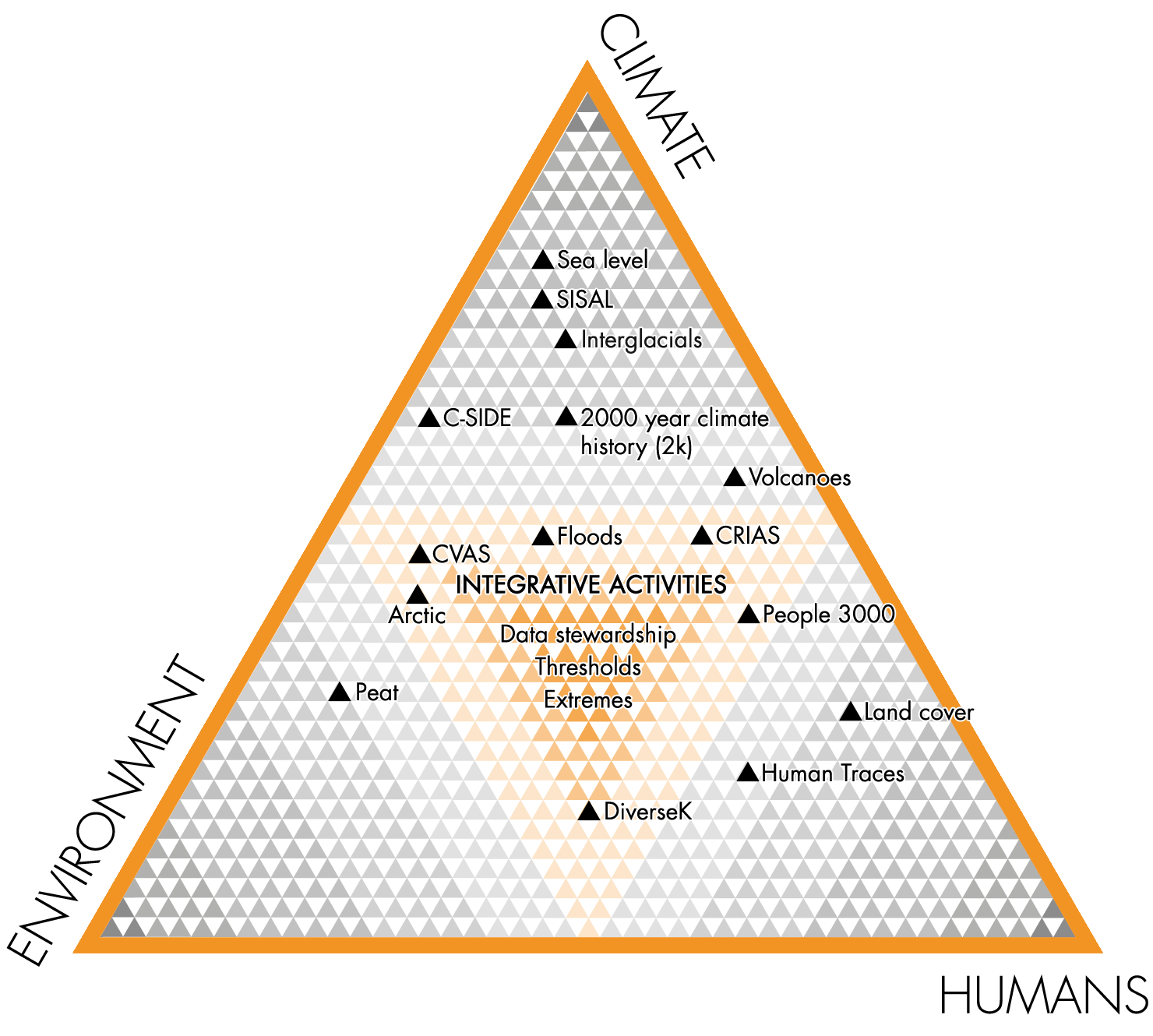 |
|
Figure 3: The PAGES ternary diagram showing the current PAGES working groups and their main focus in the three dimensional "phase space" of climate, humans, and the environment. |
The Mid-PAGES Transition
With climate-change science becoming increasingly mature and climate and environmental issues increasingly pressing, the call for more integrated and solution-oriented climate research became louder. In 2001, a first attempt was initiated to cross the borders between the four ICSU/ISSC programs (WCRP, IGBP, DIVERSITAS, and IHDP), through the so-called "Earth System Science Partnership". ESSP tried to provide an umbrella for cross-topical exchange and collaboration, but unfortunately never had the necessary traction to integrate these large, individually well-oiled science machines. In particular, the social science realm, which is a crucial element for transferring Earth system science into policy-relevant and actionable science, did not receive the attention that was proportionate to the ever-growing global disaster humankind was and still is heading towards.
Accordingly, ICSU and ISSC (which in the meantime had joined to form the cross-disciplinary International Science Council) decided to redefine from scratch the way global change science was organized. The authors of this article participated in this painstaking process, spending many a day at transdisciplinary conferences, and workshops, in discussion groups, and writing a large number of reports, statements, and countless emails. The goal of all this activity was to design a programmatic structure of global change research that would encourage interdisciplinary collaboration and involve stakeholders outside of science in the research design, while at the same time enabling core projects, such as PAGES, to continue providing the crucial science basis without which educated political decisions cannot be made.
The result of this process was the global sustainability program Future Earth, which became the umbrella organization of PAGES after IGBP officially ended in 2015. The transition of PAGES to Future Earth was a learning process for all. For Future Earth, whose motivation was to support political action with scientific information, it was not immediately clear how a project like PAGES could become policy relevant, because PAGES looks at time periods where humans were just one of many species on this planet and did not yet have comparable means to alter the entire Earth system. Eventually, understanding among the different fields and views assembled under Future Earth improved, helped along by PAGES' continuous delivery of first-class scientific products. For PAGES, the struggle at the beginning was with the concept of co-design, i.e. engaging the large range of stakeholders in PAGES' science. However, it is fair to say that by continuously scrutinizing its approach with respect to co-design and policy relevance, PAGES was able to focus even more attention on its initial goal of helping to solve global change issues.
Financial glaciation/deglaciation
PAGES had the privilege of being able to concentrate on scientific endeavors and breakthroughs, while the US and Swiss funders through their steady support provided the stability needed to initiate, establish, and nurture an international interdisciplinary network, including expansion of scientific connections and capacity in the developing world. Since the NSF and SNF only fund competitive grants, this naturally meant that PAGES had to earn its financial support by regularly submitting proposals that provided an account of previous achievements, explained the plans going forward, and justified the resources requested. While proposal writing increased the stress levels of the PAGES directors and co-chairs every four years, especially in the immediate presence of a deadline, this funding model and its inherent obligation to convince reviewers and funders clearly contributed to maintaining the excellence of PAGES over three decades. The continuing success of these proposals in a highly competitive funding landscape attests to the quality of PAGES' work.
Another long-term supporter of PAGES was and is the University of Bern, which handles the accounting and human resources management of the PAGES International Project Office (IPO). In 2009, former PAGES co-chair Heinz Wanner also convinced the university to physically host the IPO. Sharing office space with the Technical Support Unit of IPCC Working Group I during its AR5 assessment cycle and, to this day, with the Oeschger Centre for Climate Change Research of the University of Bern, provides immeasurable opportunities for synergies and joint activities to promote (paleo) climate science.
Potentially related to the PAGES transition from IGBP to Future Earth, the last five years of PAGES' history were also a time of financial insecurity, and it was not clear if or how long PAGES would survive. After 25 years of US and Swiss funding, questions about the sustainability of this funding arrangement were raised by both the NSF and SNF. The issue on the Swiss side was not financial but only an organizational one, and since 2019 the Swiss funding has been provided by the Swiss Academy of Sciences. On the US side, NSF officials were afraid that the substantial PAGES funding would exacerbate increasing demand for their funds, with a view that PAGES' funding was in competition with individual investigator projects. Accordingly, NSF asked PAGES to secure funds from other programs and from other nations and organizations, to diversify the funding platform. While this request was justified, it was not easy to implement quickly, and this sadly led to the end of sustained US NSF funding in 2018.
But PAGES would not be PAGES if it were not able to mobilize its international science network and develop new funding channels. Convincing a national funder to support an organization such as PAGES is not as simple as we all wish it could be, because typical funding streams are usually not targeted at such a hybrid between a research project and an international science-facilitating organization such as PAGES. However, in 2019, the Chinese Academy of Sciences, which through a long line of PAGES Steering Committee members had always followed and supported the progress of PAGES, stepped in to provide a share of the funding. Thus, with joint funding from the Swiss Academy of Sciences and the Chinese Academy of Sciences for the next eight years, at levels similar to those in prior years, the PAGES story can continue.
Whether it continues to be a success story, however, is not so much a matter of the funding or its sources. More importantly, PAGES' success is crucially dependent on all of us who read this article: on the new generation of outstanding early-career scientists who bring novel ideas to PAGES and are highly motivated to do their own science but also be active in representing science in the public arena; on the senior scientists, to constantly realign and redefine PAGES to keep it at the forefront of global change research and to funnel paleoscience information into the highest policy levels; and, last but not least, on the dedicated team at the International Project Office in Bern, who commit their time and energy to providing paleoscientists with the best support possible to continue interdisciplinary paleoresearch to help save the planet.
Acknowledgements
We are immensely grateful to Herm Zimmerman, Ray Bradley, and Malcolm Hughes for their engaging stories and anecdotes about the early days of PAGES (which not all made their way into this article). Great thanks also to Heinz Wanner and Christian Pfister for some Swiss perspective of past PAGES changes.
affiliations
1Climate and Environmental Physics, Physics Institute and Oeschger Centre for Climate Change Research, University of Bern, Switzerland
2Department of Earth and Atmospheric Sciences, School of Biological Sciences, University of Nebraska, Lincoln, USA
3College of Earth, Ocean, and Atmospheric Sciences, Oregon State University, Corvallis, USA
contact
Hubertus Fischer: hubertus.fischer climate.unibe.ch
climate.unibe.ch
references
Kiefer T et al. (2015) PAGES Mag 23: 44-45
Meadows DH et al. (1972) The limits to growth. Universe Books, 205 pp
PAGES Scientific Steering Committee (1994) PAGES project status and work plan (1994-1998)
Publications
PAGES Magazine articles
2021
Past Global Changes Magazine
At its core, the mission of the Past Global Changes project has remained remarkably consistent over 30 years, fostering interdisciplinarity and international collaboration to better understand and predict environmental change. The hows and whos, however, have evolved dynamically as challenges and opportunities changed over time.
Thirty years of history is a good reason for PAGES to celebrate but also to reflect on the timeliness of the endeavor. On the 20th anniversary of PAGES, one devil's advocate asked whether it wasn't time to wrap up and make room for something new. At the time, we considered the idea (only very briefly). Today, although 10 years older, PAGES is still as youthful and dynamic as ever, though in different ways. From paleoecology we know that for long-term survival and success of a species, a society or an ecosystem is required to evolve with the changing ambient conditions. The same appears to apply to international organizations in the dynamic landscape of research and innovation.
In this article, we reconstruct key indicators of the history of PAGES. As the current and previous director of PAGES, we have access to accumulated direct observations from over 15 years. Unfortunately, this reaches only halfway back to the inception of PAGES in the year 1991 CE. The history beyond direct observations therefore relies on reconstructions based on proxy data from historical documents and anecdotal evidence. As with any good paleoscientific work, we base our interpretations on occasionally patchy, potentially biased, and uncertain evidence to generate a coherent conclusion.
Science
The PAGES newsletters of the early 90s reveal that the initial focus was on pushing paleoscience research internationally, with members of the Scientific Steering Committee (SSC) advocating the paleoscience areas for which they were globally recognized pioneers. This led seamlessly into sharing the results and the excitement of existing paleoscientific projects and programs with the global PAGES community by endorsing major ongoing paleoscience initiatives, such as ice-core work in Greenland (GRIP, GISP2) and continental deep drilling (ICDP).
The first Science Plan, published in 1994, formally cast this emerging structure into an array of focus areas that has largely continued to mark the scope of PAGES to today. The focus areas became home to emblematic, big programs that attracted attention, presumably also funding for individual projects, and certainly engagement of researchers across areas of the globe that had so far collaborated only sporadically. The Science Plan was designed to foster this with global programs, such as Paleoclimate and Environments of the Northern and Southern Hemispheres (PANASH), with its three meridional Pole-Equator-Pole (PEP) transects, or the International Marine Past Global Change Study (IMAGES), with its game-changing paleoceanographic sediment-coring campaigns.
In the late 2000s it became apparent that the formerly dynamic PAGES programs might become stale after many years of existence and occupy resources that could otherwise be used for new developments. This led to the establishment of a rolling system of working groups with a limited lifetime, initiated by the community, and quality-checked by the SSC. Each group proposes final goals and outcomes in its initial proposal, thus allowing PAGES to evaluate its progress over the course of three to six years, then declare victory, sunset the working group and head for new shores. The move towards a faster-spinning machine, fueled by the innovative ideas coming from the community, resulted in the creation of more than 40 working groups since 2006 and accelerated the continuous innovation cycle that may well contribute to PAGES' youthful appearance to this day.
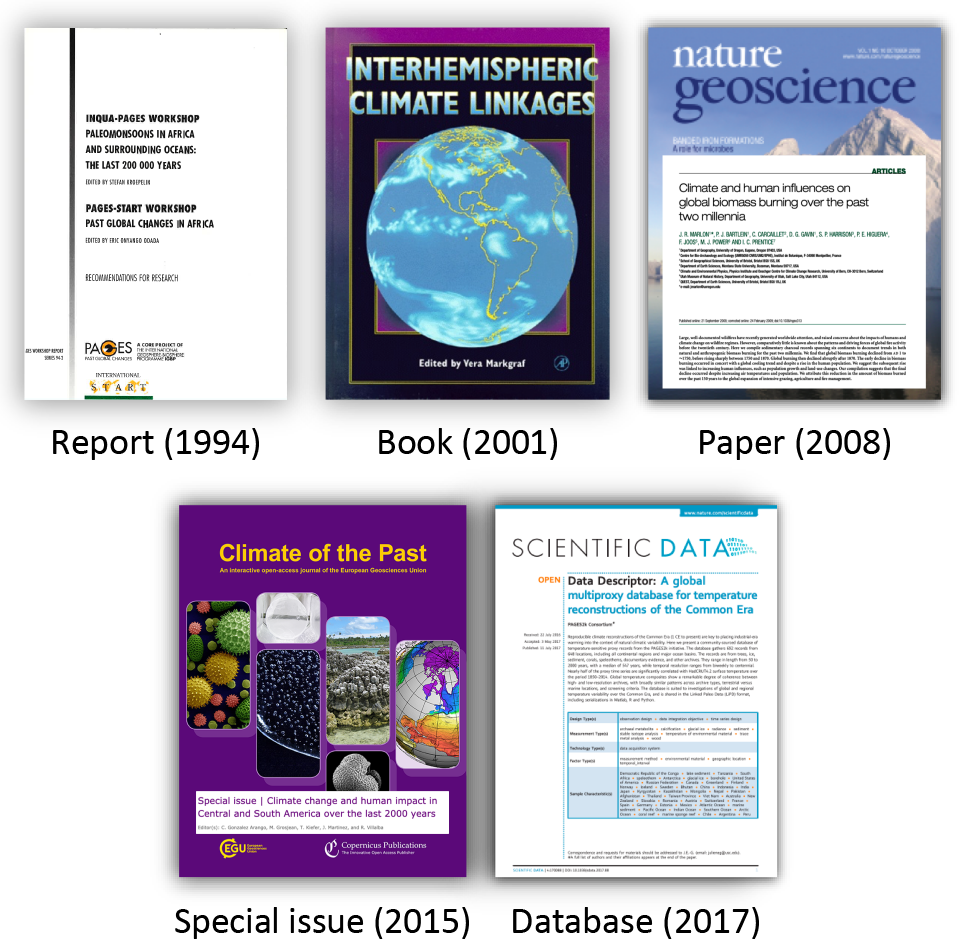 |
|
Figure 1: Examples of popular publication formats through time (Kroepelin and Odada 1994; Markgraf 2001; Marlon et al. 2008; Gonzalez Arango et al. 2015; PAGES2k Consortium 2017). |
Another striking evolution of PAGES relates to the kind of primary scientific publications resulting from PAGES' activities (Fig. 1). The pioneers of PAGES loved to produce pretty reports that were quick to flick through, appealing to look at, and a pleasure to read. The next generation produced hard-cover books that summarized copious amounts of information, suitable also to take pride of place on every paleoscientist's bookshelf. With the dawn of the new millennium, however, reports and books were abandoned, as peer-reviewed scientific papers rose in popularity: succinct, quality-validated, citable, downloadable, and increasingly career-relevant for the authors. Several community papers in high-profile journals have contributed to raising the profile of PAGES' approach to generate excellence through global collaboration.
While the regard for academic papers remains high to this day, a competitor (or complement) recently entered the stage in the form of databases and data products, such as those on the climate of the past 2000 years, paleofire, and speleothems. This nicely converges back to a vision of PAGES' pioneers for global data sharing through comprehensive paleoscience data centers. It will be interesting to see what product formats will characterize PAGES' next decade.
Community
The centerpiece of PAGES today is uncontestably its global community of active researchers and other experts. They believe in the power of collaboration to drive forward their field of science with passion, recognizing that the energy and creativity of the community accelerates their individual research objectives.
In its inaugural days, PAGES was driven by world leaders in the still-young disciplines of paleoclimatic and paleoenvironmental science. They had the scientific standing and the exciting research projects at their fingertips to raise a strong profile for the newly founded PAGES project. In the late 90s and early 2000s, PAGES created entry points for participation by paleoscientists from different disciplines worldwide. Since the late 2000s, all members and followers of the paleoscience community can propose and, if successful, run a working group to contribute to the advancement of paleoscientific understanding and capacity.
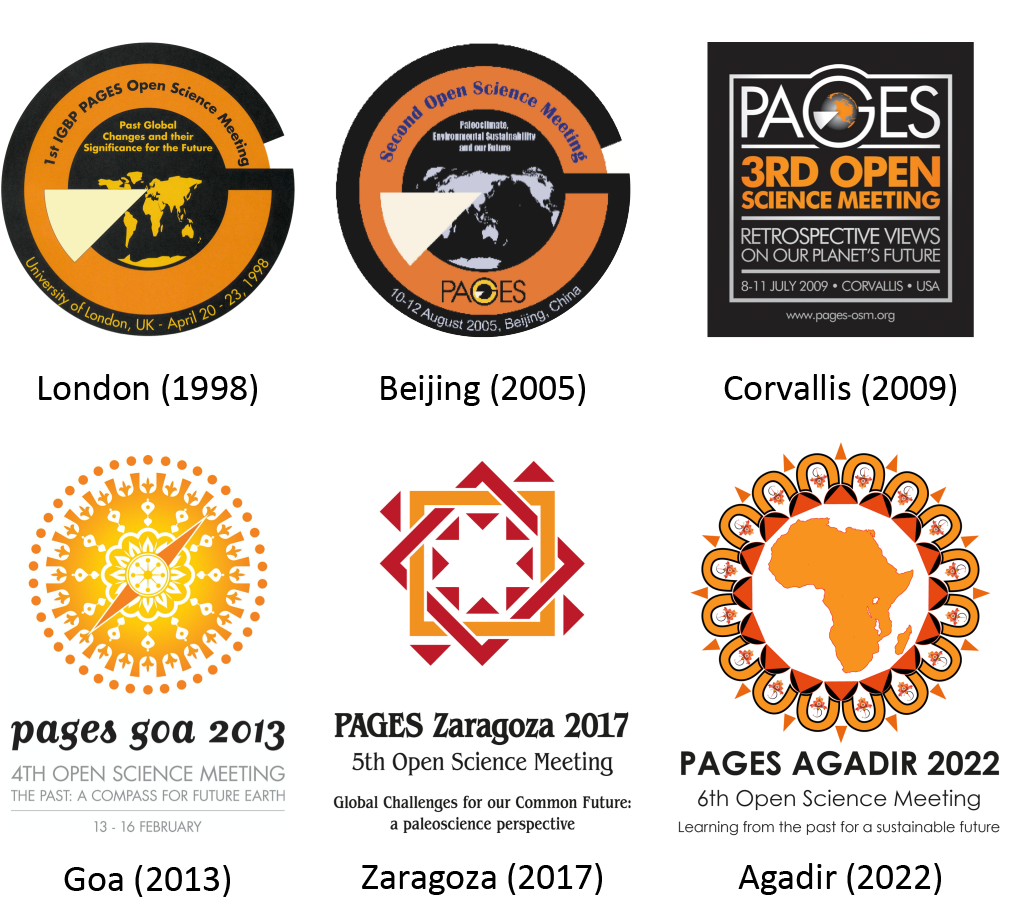 |
|
Figure 2: Logos of all five PAGES Open Science Meetings that have taken place so far and of the one to look forward to in 2022. |
Finally, over the last decade, the PAGES community witnessed a spectacular diversification, not only scientifically and geographically, but also by achieving healthy balances of gender and across the career spectrum. The early-career researchers, specifically targeted with a first Young Scientists Meeting (YSM) in 2009, are today a driving force in PAGES through regular YSMs, our own Early-Career Network, and a seat on the SSC.
Once every few years the PAGES community gathers at the Open Science Meeting (OSM). Meetings during the years 1998, 2005, 2009, 2013, and 2017 were held in London, Beijing, Corvallis, Goa, and Zaragoza (Fig. 2). Writing this article during the pandemic years 2020/21, it is not without melancholy that we recall many in-person paleoscientific exchanges with international colleagues at those locations. If you need something to look forward to, mark your calendar with the upcoming OSM in Agadir, Morocco, from 15–21 May 2022!
Communication
Probably the most visible and continuous expressions of how PAGES, and indeed the world, has evolved over the last three decades are our means of communication. To get a sense of how long PAGES has been around, consider that it existed for several years without a web presence – unthinkable today, but the norm back in the early 90s. It was not until 1997 that PAGES' first website went live, initially hosted by NOAA, then soon afterward by the University of Bern. Since then, the website has been the main point of reference for information and a resource for PAGES products. Figure 3 invites you to travel through different times of web design and to enjoy the brand-new website that was launched to celebrate PAGES' 30th anniversary.
Another extremely important PAGES outlet is its magazine. PAGES news was launched in 1993 as a compact four-page leaflet, printed and mailed to subscribers (Fig. 4). Since then, it has grown considerably in size and scope, including more and more information about PAGES' scientific activities and findings. In April 1997, for the first time, a thematic focus was published in PAGES news, emphasizing the activities going on within two of the three PEP Transects and soliciting article contributions from experts within the PAGES community. The concept of an appealing in-house publication with a core of scientific articles that are sometimes even cited in peer-reviewed papers has persisted ever since. In 2014, PAGES took the obvious step to rename its publication into what it had actually become, a magazine-style publication with relevance not only for the PAGES project but with recognition in the field of paleoscience and beyond: Past Global Changes Magazine, impossible to miss in its bright orange design, was born.
With the rise of electronic mail, PAGES moved the spread of network information such as upcoming events, deadlines, and activities from the printed PAGES news to the much faster medium of email. In 2001, the first PAGES e-news was sent out, making sure that subscribers received information about opportunities well before the deadlines. What seemed fast at the time is slow today. Since PAGES entered the social media world in 2010, information is shared also as decentralized, real-time updates and interactive exchanges via Twitter and Facebook – but fear not, recent polls have revealed that a critical mass of paleoscientists still appreciates their information spoon-fed in menu format and many even still appreciate reading the magazine on good old paper. Therefore, PAGES will continue with the e-news and magazine hardcopies into its fourth decade.
 |
|
Figure 4: Stepwise evolution of the layout of Past Global Changes Magazine, formerly known as PAGES news. |
It is always the ultimate commendation when figures from the magazine are used in conference presentations and education. From 1994 to the early 2000s, PAGES offered its most iconic figures for copying or printing as overhead slides, and until 2016 all magazine figures were downloadable as PowerPoint files. While content-extraction software has now made separate provision of figures redundant, everyone should continue to feel welcome to use material from the PAGES website and Past Global Changes Magazine extensively for free (with an enthusiastic reference to PAGES, please*).
Behind the scenes
Two more factors have been essential for the long life and success of PAGES. First, the generous long-term funding by the National Science Foundations of Switzerland and the US, substituted in 2019 by the Academies of Sciences of Switzerland and China, provided the necessary cash resources. With this foundation, PAGES was able to develop its science agenda and structure as described above to constantly improve the organization. (For more information on the history of funding and the players behind it see Fischer et al. this issue.)
Second, as the authors of this retrospective and as executive directors who cumulatively escorted PAGES through more than half of its lifetime, we pay tribute to the staff of the PAGES International Project Office. Under the guidance of five different executive directors, approximately 40 staff members have supported projects, liaised with the community, edited newsletters, created websites, updated content, administered finances, disseminated information, and contributed in many other ways to the establishment of PAGES as an efficient program with a dedicated mission and a friendly face.
To date, PAGES has almost 5500 subscribers: around 500 attend workshops each year, about 200 co-author articles in Past Global Changes Magazine each year, and almost 900 were at the last OSM in Zaragoza in 2017. With this crowd, the future of PAGES is bright! The 30-year anniversary offers an opportune moment to look back with humble pride and look forward with vivid anticipation.
*To use material published by PAGES, please be sure to follow the CC-BY guidelines: creativecommons.org/licenses/by/4.0/
affiliations
1Joint Programming Initiative Healthy and Productive Seas and Oceans, Brussels, Belgium
2Past Global Changes International Project Office, Bern, Switzerland
contact
Thorsten Kiefer: thorsten.kiefer jpi-oceans.eu
jpi-oceans.eu
references
Markgraf V (2001) Interhemispheric Climate Linkages. Academic Press, 454 pp
Marlon JR et al. (2008) Nat Geosci 1: 697-702
Hajdas I et al. (Eds) (2006) PAGES news 14, 32 pp
Larocque I et al. (Eds) (2002) PAGES news 10(1), 24 pp
Ojala A et al. (Eds) (2003) PAGES news 11(2-3), 36 pp
Oldfield F (Ed) (1997) PAGES news 5(2), 16 pp
PAGES2k Consortium (2017) Sci Data 4: 170088 Supplementary material
Publications
PAGES Magazine articles
2021
Past Global Changes Magazine
In a human life, reaching 30 years is usually a notable milestone. The teething troubles are long behind us, the endless school days are over, perhaps a university degree is in our pocket, there are no parents to tell us what to do and what not to do, and, if we're lucky, we have a stable income and a career underway. It is the time where we feel that we have achieved something important and that our actions have an impact.
As with all analogs, this one has its limits, but having edited this special 30-year anniversary issue of the Past Global Changes Magazine (which contains articles that look at the past, present, and future of PAGES from various perspectives), we feel that 30 years is not such a bad age for PAGES either. Born as an idea of a few visionary and influential climate scientists 30 years ago (see: overbearing parents above), PAGES has overcome obstacles and growing pains, developing from a small structure into a vibrant interdisciplinary body, and has certainly left its mark on the climate research landscape.
Of course, some boundary conditions have always governed what the PAGES objectives were, but within this framework PAGES has been a leader in filling a void in climate and sustainability research. PAGES members have synthesized observations and reconstructions from paleoclimatic archives, in conjunction with models, to identify processes and changes in the Earth system, and use them to put the present and future climate into context.
Thirty years may also be the age where we realized that growth may not just be in the vertical direction but may also proceed sideways, and that we have to exercise more and make a greater effort to stay fit than we did in previous years. Certainly, the sphere of scientific questions and the composition of the community of PAGES has grown oblate over the years. PAGES is now a community of almost 5500 subscribers, 15 working groups, and more than 500 active working group members. The last PAGES Open Science Meeting in Zaragoza, Spain, drew a crowd of nearly 900! So yes, PAGES has grown both in length and girth, but its vast science output shows that it has never been fitter. The articles in this issue, a sample of working groups combined with a series of articles by the PAGES Early-Career Network, attest not only to the excellent output and the imprint left by PAGES on Earth Sciences, but also to the promise of more from the next generation of PAGES leaders.
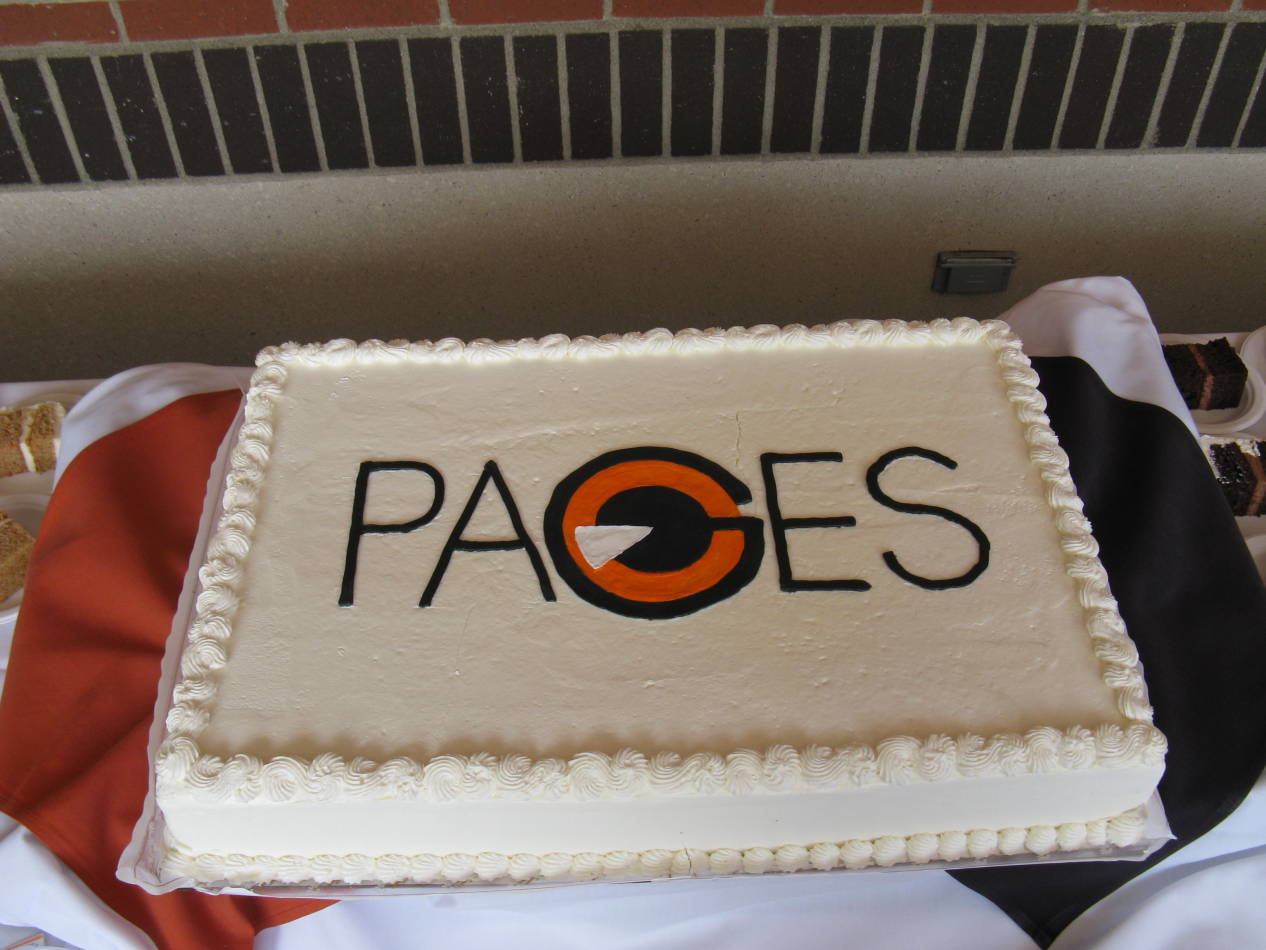 |
|
Figure 1: PAGES also celebrated reaching adulthood at the PAGES 3rd Open Science Meeting in Corvallis, OR, USA, in 2009 (Image credit: Nick Rackebrandt). |
Success does not necessarily always follow growth and experience, but we are optimistically looking into the future. With a stable financial background secured for the coming decade, it is essentially up to the PAGES members to fill its science plan with new, innovative ideas, science questions and paleoscience perspectives, and insights relevant for the challenges that lie ahead for mankind in terms of climate change, biodiversity loss, and a sustainable use of natural resources. Looking at the many early-career researchers who are carrying PAGES forward and infusing PAGES with new ideas (as shown in the series of articles in the section "Highlighting the future of past global change research" in this magazine), there is little to worry about.
As is common when celebrating such a round anniversary, there is always someone standing up to give a sometimes mildly funny and often too-long speech on behalf of the person celebrating the jubilee. We don't want to be that someone, so we had better stop here. But as is also customary in these cases, we cannot resist toasting PAGES:
"To the next 30!"
And why not?!
Affiliations
1Climate and Environmental Physics, Physics Institute and Oeschger Centre for Climate Change Research, University of Bern, Switzerland
2Department of Earth and Atmospheric Sciences, School of Biological Sciences, University of Nebraska, Lincoln, USA
3Department of Geology and ESSIC, University of Maryland, College Park, USA
contact
Hubertus Fischer: hubertus.fischer climate.unibe.ch
climate.unibe.ch
Publications
PAGES Magazine articles
2020
Past Global Changes Magazine
Daniel M. Gilford1, S. Coulson2 and V. C. Alvarez3
PALSEA Express virtual meeting, 15-16 September 2020
Unconventional and historic, the first-ever virtual PALeo constraints on SEA level rise (PALSEA; pastglobalchanges.org/science/wg/palsea/intro) Express workshop (pastglobalchanges.org/calendar/2020/127-pages/2043) was held in September, fostering valuable scientific exchanges among new and established community members. Eight invited speakers, 23 poster presenters, and a record number of over 200 attendees focused on improving their understanding of ice-sheet and solid-Earth processes that drive paleo sea-level change.
A new compilation of Northern Hemisphere (NH) ice-sheet extent through the Quaternary (Batchelor et al. 2019) showed key spatial differences in ice-sheet configurations between glacial cycles, emphasizing the ongoing need to gather new field evidence and constrain past ice-sheet extents for modeling study support. Data standardization and consolidation has been a core goal of the PALSEA community over the last decade. Workshop presentations promoted open and accessible data and methods, highlighting the growing number of tools and databases available to the community, and their usefulness. One talk, for example, illustrated the importance of sea-level databases for assessing coastal environment vulnerability (Horton et al. 2019).
The uncertain fate and historical evolution of the Antarctic Ice Sheet (AIS) was an overarching theme of the meeting. The AIS is strongly coupled with the surrounding Southern Ocean, driving important ice-ocean interactions which feed back on AIS stability. Several invited talks considered the physical mechanisms controlling this stability, including brittle ice-sheet processes and feedbacks between meltwater pulses, ocean stratification, and basal AIS melt. An improved ice-sheet model capturing hydrofracturing and calving of marine-terminating ice shelves (e.g. observed Crane Glacier retreat over 2002–2003, Fig. 1) suggested more Last Interglacial (LIG) AIS retreat than previously thought, bringing LIG global mean sea-level estimates closer to (though not fully reconciling them with) those from observed sea-level indicators. A report from the WArm Climate Stability of West Antarctic ice sheet in the last INterglacial (WACSWAIN; https://www.esc.cam.ac.uk/research/research-groups/wacswain) field campaign outlined critical ongoing efforts to document LIG AIS extent with >600-m ice cores.
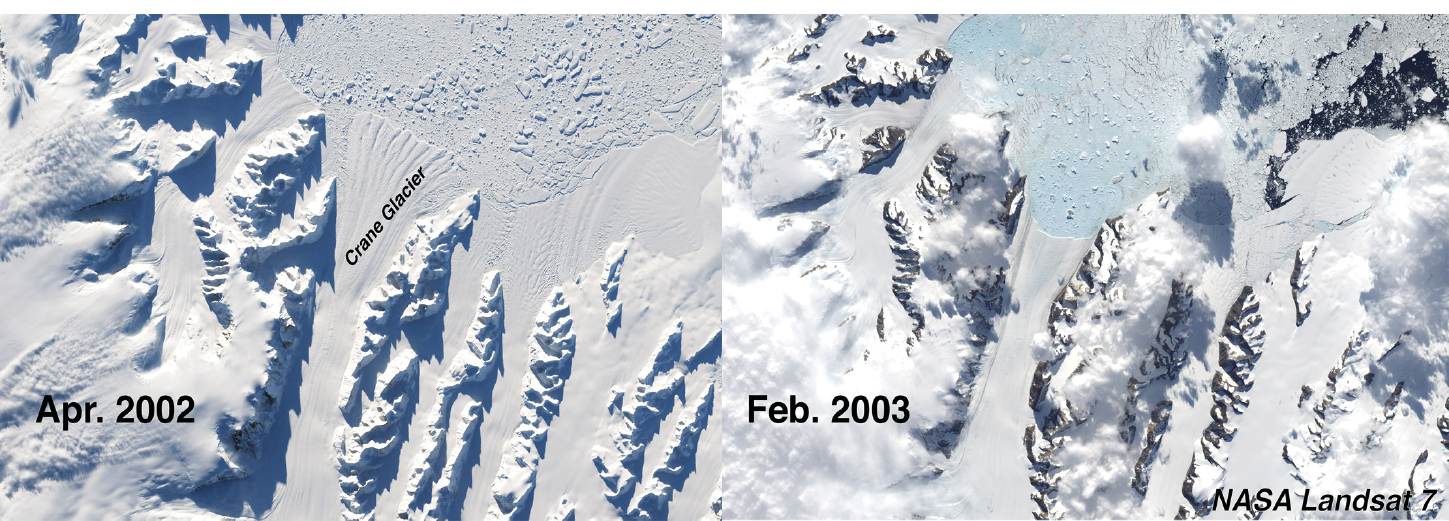 |
|
Figure 1: The stunning retreat of Crane Glacier (West Antarctica) following ice-shelf crevassing and collapse in 2002 (NASA; https://earthobservatory.nasa.gov/images/43459/retreat-of-crane-glacier-antarctic-peninsula). |
Coupled sea-level ice-sheet models demonstrated the considerable influence that NH ice-mass changes can have on AIS variability (Gomez et al. 2020). Dramatic melting of NH ice sheets during the most recent deglaciation (~14,000–10,000 years ago) led to geographically variable sea-level rise around Antarctica, driving increased AIS mass losses (since flux across the grounding line is proportional to water height), and may have affected AIS stability during the Holocene and LIG. Additional insights from glacial isostatic adjustment (GIA) models and the incorporation of 3D Earth structure were central themes of the virtual poster session.
Advances by the paleo sea-level community also raised old questions. Several presentations built on John Mercer's classical paper (1968), suggesting LIG sea-level highstands could inform future sea-level rise. However, LIG peak sea level remains elusive, with recent estimates showing little change from the 6–9 m estimated by a landmark review five years ago (Dutton et al. 2015). Combining evidence from Bahamian coral terraces, GIA models, and a machine-learning technique, one speaker suggested LIG peak sea level could have been as low as 1.1 m (Dyer et al. in review in Sci Adv), bringing previous higher estimates into question. Other challenges discussed were the relative timing of Antarctic and Greenland ice-sheet retreat during deglacial periods, the role of spatially varying mantle viscosity in ice-sheet stability, and whether certain sea-level indicators can be considered eustatic.
The virtual nature of the workshop encouraged broader academic diversity, including participants from 34 different countries. Removing financial and travel barriers noticeably increased participation and involvement from early-career researchers. Attendees highlighted the impact of the pandemic and political and racial unrest on the paleo sea-level science community, and in particular the need to support young scientists. Discussions also emphasized the paramount importance of diversifying our community moving forward and supporting initiatives such as #BlackInGeoscienceWeek. We hope PALSEA Express 2020 was the first of many such successful virtual meetings.
Acknowledgements
Many thanks to workshop organizers Jacky Austermann, Alexander Simms, Natasha Barlow, Jeremy Shakun, and Alessio Rovere, and to the many institutions that provided Zoom access throughout the virtual meeting. We also thank PAGES, the International Union for Quaternary Research (INQUA), and the Scientific Committee on Antarctic Research Solid Earth Response and influence on Cryospheric Evolution program (SCAR-SERCE) for their support.
Affiliations
1Institute of Earth, Ocean, and Atmospheric Sciences, Rutgers University, New Brunswick, NJ, USA
2Department of Earth and Planetary Sciences, Harvard University, Cambridge, MA, USA
3School of Earth and Environment, University of Leeds, UK
contact
Daniel M. Gilford: daniel.gilford rutgers.edu
rutgers.edu
references
Batchelor CL et al. (2019) Nat Commun 10: 3713
Dutton A et al. (2015) Science 349: aaa4019
Gomez N et al. (2020) Nature 587: 600-604
Publications
PAGES Magazine articles
2020
Past Global Changes Magazine
PAGES 2k Network coordinators
Currently in its 13th year, the PAGES 2k Network (pastglobalchanges.org/2k) entered its third phase in 2017. This phase is scheduled to sunset at the end of 2021. In order to gather feedback, the coordinators surveyed current participants and the broader 2k Network community in June 2020. We are grateful to the 49 respondents who took the time to provide thoughtful feedback, including one of the original founders of the Network (self-identified).
Responses came largely from scientists who completed their PhD more than eight years ago (76%). Many respondents have been involved in one or more of the Phase 3 projects (ARAMATE, CLIM-ARCH-DATE, CLIVASH2k, CoralHydro2k, Global T CFR, GMST reconstructions, Iso2k, MULTICHRON, PALEOLINK, PSR2k; pastglobalchanges.org/science/wg/2k-network/projects) as a project member (29%), project coordinator (8%), contributor to database compilation efforts (33%), and/or manuscript co-author (31%).
Approximately half of all respondents, including those not directly involved in the working group, had used data provided by the projects and previous 2k Network efforts (45%). While some of the projects are still gaining momentum, others are in the process of disseminating their final results or have already concluded. The collective effort has been impressive; outputs have included comprehensive datasets (Fig. 1) and data-model comparisons, and several papers have already been published (e.g. Bracegirdle et al. 2019, Neukom et al. 2019, PAGES 2k Consortium 2019, Bothe and Zorita 2020, Konecky et al. 2020).
Survey respondents gave useful suggestions for improving the PAGES 2k Network and its coordination, including communication, via circulars or online meetings, as well as by enabling interested parties to more easily become involved with the ongoing efforts. The responses also highlight the importance of facilitating networking among participants at different career stages and in different geographical regions, as the network consists of a large number of both early-career researchers and more established scientists spread around the globe.
Looking forward to the scientific challenges that the PAGES 2k Network and the broader community should work to solve over the next five to 10 years, many respondents agreed that better data coverage is necessary, both spatially and temporally, in order to resolve greater detail. There was a call to extend the focus further back in time, such as the past 5000 years or as far back as the early Holocene. On the other side of the spectrum, some respondents suggested making the connection to future climate change more prominent. Others commented on the focus on temperature reconstructions and suggested expanding this to include hydroclimate or human–climate interactions. Development of new proxies and data-model integration were also identified as potential goals. As some of the projects of the PAGES 2k Network are creating databases, there was also concern about the future maintenance of these databases once the working group eventually sunsets.
Approximately half of the survey respondents were enthusiastic about a subsequent fourth phase (44%), while 46% felt that it was time to wrap up the working group and transition efforts to work on the challenges identified above. While no definite plans have yet been made, the coordinators are currently considering options for online events in 2021 as well as possibilities to reach out to the wider community in person at the PAGES Open Science Meeting in Agadir, Morocco, in May 2022. We hope to use this opportunity to provide networking opportunities, workshops, and/or a celebration of the past 13 years of this working group. Updates will be available at pastglobalchanges.org/calendar/upcoming/127-pages/2065.
Phase 3 of the PAGES 2k Network built on the strong foundation established during the preceding eight years; the success of the network is largely due to the enthusiasm and energy of the many scientists at all career stages who have contributed over this period. Regardless of the future of this working group, we hope to be able to pass on the expertise that has been accumulated, particularly in online community collaboration, to the next generation of paleoscientists and PAGES working groups.
Authors and affiliations
N.J. Abram (The Australian National University, Canberra, Australia)
O. Bothe (Helmholtz-Zentrum Geesthacht Centre for Materials and Coastal Research, Geesthacht, Germany)
S. Eggleston (PAGES International Project Office, Bern, Switzerland)
B.L. Konecky (Washington University, St. Louis, USA)
H.W. Linderholm (University of Gothenburg, Sweden)
B. Martrat (Institute of Environmental Assessment and Water Research IDAEA-CSIC, Barcelona, Spain)
H. McGregor (University of Wollongong, Australia)
S.J. Phipps (University of Tasmania, Hobart, Australia)
S. St. George (University of Minnesota, Minneapolis, USA)
contact
Sarah Eggleston: sarah.eggleston pages.unibe.ch
pages.unibe.ch
references
Bothe O, Zorita E (2020) Clim Past 16: 341-369
Bracegirdle TJ et al. (2019) Geosciences 9: 255
Konecky BL et al. (2020) Earth Syst Sci Data 12: 2261-2288
Publications
PAGES Magazine articles
2020
Past Global Changes Magazine
The PAGES ECN Steering Committee
The PAGES Early-Career Network (ECN; pastglobalchanges.org/ecn) was developed to create a permanent platform for early-career researchers (ECRs) to exchange ideas, perform outreach, engage in skill development, and find collaborations among fellow ECRs within PAGES. The PAGES ECN is an integral part of PAGES and provides a platform for all ECRs, whether or not they are directly involved with an active PAGES working group. Moreover, the ECN helps ECRs become more involved in the scientific community and within PAGES.
Originally founded by 11 ECRs following the 2017 PAGES Young Scientists Meeting in Spain, the structure of the group has evolved as membership has grown. The Steering Committee, now comprising 10 members serving fixed terms, largely oversees visioning, communication, and coordination of activities among different branches of the group.
Many initiatives and activities have recently grown into activity "clusters". Any ECN member is welcome to initiate or join a cluster, which is run relatively independently, albeit in close communication with the Steering Committee. With this new cluster structure, we aim to increase diverse and global representation within the PAGES ECN and encourage collaboration among members. We invite ECRs from various backgrounds to bring in their ideas and engage in leadership roles, whether they are directly managing ongoing activities (e.g. the blog) or single products (e.g. a local workshop). In this article, we introduce our updated structure and some exciting new initiatives.
Training and networking events are organized by the Workshop and Webinar clusters, with annual workshops and webinars on topics relevant for ECRs as well as for the wider paleoscience community. The Write Club cluster organizes online writing retreats for members to commit scheduled time to writing in a focused atmosphere. The Blog cluster organizes our peer-reviewed blog, The Early Pages (theearlypages.blogspot.com), giving ECRs the opportunity to share their research and stories and gain experience in the review process. The Science cluster is the most recent initiative to be formed, which aims to facilitate scientific collaboration and new projects among ECRs. The ECN clusters also catalyze opportunities for ECRs beyond PAGES, such as the ECR workshop "Past Socio-Environmental Systems" (PASES; pases2020.com), jointly organized with INQUA (inqua.org/ecr).
Each PAGES working group has at least one member serving as an ECN liaison to ensure optimal communication about opportunities for ECRs in PAGES. Regional representatives from countries worldwide work to promote the ECN and PAGES among peers in their region. Regional representatives support the ECN by sharing job, funding, and other opportunities from their region and are a point of contact for local ECRs. Many new initiatives within the ECN are driven by regional representatives, in connection with the activity clusters (Fig. 1). For example, regional representatives in Central and South America have organized several Spanish-language webinars and those in Africa are developing an interactive database to track opportunities for ECRs within their region. New ideas for workshops, outreach, and other ECN products are also being developed by the Steering Committee, regional representatives, and other active ECN members.
All interested ECRs of PAGES are welcome to join the ECN to participate in any of our activities or share ideas and contribute to our products. If you are interested in joining or leading a cluster, please send an email to the appropriate contact (an overview and contact information is found on our website: pastglobalchanges.org/ecn/clusters).
Initiatives to form new clusters are welcome as well. If you want to learn more about our activities in general, go to our website (pastglobalchanges.org/ecn) or contact your local regional representative (pastglobalchanges.org/ecn/support). You can also subscribe to the ECN mailing list (listserv.unibe.ch/mailman/listinfo/pages.ecn.pages) to receive our monthly newsletter and general announcements.
Authors and affiliations
S.J. Alexandroff (University of Exeter, UK)
X. Benito (National Socio-Environmental Synthesis Center (SESYNC), University of Maryland, Annapolis, USA)
A. Bonk (University of Gdańsk, Poland)
M. Mette (US Geological Survey, St. Petersburg Coastal and Marine Science Center, FL, USA)
N. Schafstall (Czech University of Life Sciences, Prague, Czech Republic)
T. Trofimova (NORCE Norwegian Research Centre, Bjerknes Centre for Climate Research, Bergen, Norway)
contact
PAGES ECN Steering Committee: pages.ecn gmail.com
gmail.com
Publications
PAGES Magazine articles
2020
Past Global Changes Magazine
Deirdre D. Ryan1, S.J. Alexandroff1,2, F.A. Lechleitner3, N. Schafstall4, T. Trofimova5 and H. Detlef6
In January 2020, a survey was sent to PAGES early-career researchers (ECRs) to assess their understanding of PAGES' structure, awareness of support offered by the PAGES Early-Career Network (ECN; pastglobalchanges.org/ecn), and the involvement of ECRs in working groups (WGs). The latter assessment serves as an important baseline metric for active efforts by PAGES to improve ECR involvement in WGs.
The survey was developed by this article's authors and spearheaded by Dr. Henrieka Detlef. PAGES members who identified as ECR on their member profiles and those subscribed to the ECN mailing list were emailed survey requests. Recognizing there may be some overlap, this totalled 653 PAGES members. We received 123 responses (~19%); however, eight of the survey participants had no awareness of WGs, so the results presented here are based upon the responses of the remaining 115 individuals (Fig. 1). The survey results are not considered representative of all PAGES ECRs.
Half of the respondents (51%, 59 of 115) are subscribed to at least one WG mailing list, but only 26% (30) consider themselves to be an active or contributing member to at least one WG. Most active members (98%) consider WG involvement beneficial to their career. The majority of active members are either postdoctoral researchers or PhD students located in Europe or North America, followed by South America and Australia/Oceania, and then Africa and Asia. Involvement in WGs is most commonly initiated through attendance at a WG workshop and/or through a supervisor. We were unable to assess the representation of ECRs within WGs as records of membership are not maintained by WGs.
The survey helped to identify hurdles for ECR involvement in WGs. A large percentage (71%) of respondents, who were aware of WGs and/or subscribed to a WG mailing list, have never approached a WG regarding membership. Barriers to ECR involvement in WGs included not knowing how to join a working group, the impression that they have nothing to offer or that they may not be welcome to join a WG, and a lack of any WG that fits their research. Four survey participants who did approach WGs for membership were unsuccessful due to a lack of positive response from the WG.
Survey participants were also asked to provide suggestions on how to facilitate the inclusion and involvement of ECRs in WGs. The most repeated suggestion was more funding to cover travel costs. Other responses were:
• An annual open call by WGs for new membership;
• Active efforts by WG members to invite ECRs and involve ECRs in new projects;
• Virtual options for all WG meetings and workshops;
• A mentoring program with senior scientists who are willing to provide support to ECRs from disadvantaged backgrounds or whose supervisors are not active within PAGES.
Other efforts to enhance ECR involvement are already underway. Since 2018, every WG has been required to appoint an ECR as liaison to the PAGES ECN. New WGs are encouraged to include ECRs in the steering group and highlight their participation in the proposal. Workshop funding is primarily reserved for the support of participating ECRs. In addition, the PAGES ECN has started a science cluster which aims to connect ECRs who want to start new WGs or collaborate on other scientific projects. Finally, a webinar series is slated to begin before the end of 2020 that will focus on how ECRs can engage in existing WGs. Announcements will be made on the PAGES ECN website and in the PAGES e-news as these activities develop.
affiliations
1MARUM – Center for Marine Environmental Sciences, University of Bremen, Germany
2College of Life and Environmental Sciences, University of Exeter, UK
3Department of Chemistry and Biochemistry and Oeschger Centre for Climate Change Research, University of Bern, Switzerland
4Czech University of Life Sciences, Faculty of Forestry and Wood Science, Department of Forest Ecology, Prague, Czech Republic
5NORCE Norwegian Research Centre, Bjerknes Centre for Climate Research, Bergen, Norway
6Department of Geoscience, Aarhus University, Denmark
contact
Henrieka Detlef: henrieka.detlef geo.au.dk
geo.au.dk
Publications
PAGES Magazine articles
2020
Past Global Changes Magazine
Raphaël Hébert, M. Casado and T. Laepple
Climate variability occurs at all timescales, encompassing periodic oscillations such as daily and annual cycles at short timescales and the Milankovitch periodicities at longer timescales, as well as the scaling continuum of climate variability which contains continuously increasing variance with timescale. The climatic signal of the recent instrumental period, when direct measurements are available, contains both natural and anthropogenic signatures. This makes attribution and detection of climate change complicated, particularly at the regional scale where forced variability plays a relatively smaller role.
To demodulate the internal variability from the response to external forcing, which is necessary to improve future climate projections, it is thus needed to go beyond the instrumental record. For instance, it remains uncertain whether the internal variability is dependent on the background state, and thus whether we should expect a warmer world to be more stable, or more variable with increasing occurrence and magnitude of extreme events.
In this context, paleoclimate records are a unique tool to extend our observation of climate variability to longer timescales, to be able to study not only the climate system without the impacts of human activity, but also different background states characterized by various combinations of orbital parameters, greenhouse gas concentrations, climatic conditions, and geological configurations.
Challenges remain, however, in the interpretation of paleoclimate proxies, as many archival processes are involved, each of which may affect the recorded signal. For instance, precipitation intermittency creates aliasing in ice-core records, and then diffusion acts as a low-pass filter (Casado et al. 2020). Similarly, aliasing is created in sediment cores by seasonality and the sampling scheme, while bioturbation and sediment mixing also act as low-pass filters (Dolman et al. 2020). Those non-climatic processes lead to timescale-dependent biases and errors (Kunz et al. 2020) which may completely dominate the climatic signal over particular timescale bands (Fig. 1).
Proxy system modeling (PSM) is crucial in order to recognize and quantify proxy-specific biases, and allow for a formal characterization and interpretation of the transfer function from the climate input to the recorded signal. The further development of PSM is thus an important topic of paleoclimate research and at the heart of CVAS' (pastglobalchanges.org/cvas) research goals, building on the legacy and integrating the former Paleoclimate Reanalyses, Data Assimilation and Proxy System modeling (DAPS; pastglobalchanges.org/daps) group.
Another important aspect of the second phase of CVAS is the development and improvement of statistical tools for the analysis of timeseries and spatial distributions. These will be made available to other PAGES working groups to further space-time analysis in the broader geoscience community.
Both the PSM and statistical tools developed will contribute essential elements to the overarching aim of CVAS: a comprehensive synthesis of the spatio-temporal structure of climate variability, or "the CLIMAP of temperature variability". This implies a particular focus on decadal- to millennial-scale variability, where the greatest knowledge gap lies. Beyond the rather complete picture provided by instrumental data up to decadal timescales, the very long timescales (>10 kyr) are also relatively well quantified since there are few effective spatial degrees of freedom remaining, i.e. a few high-quality timeseries effectively represent the global behavior. The PAGES 2k Network (pastglobalchanges.org/2k) and Speleothem Isotopes Synthesis and AnaLysis (SISAL; pastglobalchanges.org/sisal) working groups will therefore provide very valuable information, which will be at the core of our investigation.
CVAS will subsequently explore the implications of the results for future reconstruction and assimilation efforts, and also for constraining future climate evolution. While climate models have demonstrated their ability to produce realistic forced climate variability, important modeling challenges remain to accurately capture internal feedbacks and processes necessary to close the variance gap with regional climate reconstructions at longer than multidecadal scales (Laepple and Huybers 2014).
The environment, biodiversity, and human society are all linked to the stability of the Earth system and its sensitivity to external forcing, as well as the statistics of extremes. These are thus central topics in PAGES' holistic Earth system science approach, and CVAS has accordingly adopted an interdisciplinary approach based on statistical and spectral analysis. The application of CVAS concepts beyond climate variability will also be explored. Particularly through potential collaboration with the Resistance, Recovery and Resilience in Long-term Ecological Systems (EcoRe3; pastglobalchanges.org/ecore3) and PalEOclimate and the PeopLing of the Earth (PEOPLE 3000; pastglobalchanges.org/people3000) groups, we will investigate possible linkages and interactions between physics and life on timescales longer than centuries.
affiliation
Alfred-Wegener-Institut for Polar and Marine Research, Potsdam, Germany
contact
Raphaël Hébert: raphael.hebert awi.de
awi.de
references
Casado M et al. (2020) Clim Past 16: 1581-1598
Dolman A et al. (2020) Clim Past Discuss, doi:10.5194/cp-2019-153
Publications
PAGES Magazine articles
2020
Past Global Changes Magazine
Nikita Kaushal1, F. Lechleitner2 and L. Comas-Bru3
Phase 1: Achievements
Speleothems are important paleoclimate archives because of their global distribution and exceptional age control. During Phase 1 (2017–2020), the PAGES working group Speleothem Isotopes Synthesis and Analysis (SISAL; pastglobalchanges.org/sisal) built a global network of speleothem researchers and created a global database of speleothem oxygen and carbon isotopes. Led mainly by early-career researchers, the group has published three database versions (SISAL_v1: Atsawawaranunt et al. 2018a, 2018b; SISAL_v1b: Atsawawaranunt et al. 2019; Comas-Bru et al. 2019; SISAL_v2: Comas-Bru et al. 2020a, 2020b). SISAL_v2 contains nearly 700 speleothem records with standardized age models and incorporates most of the speleothem records published so far (see Fig. 1).
The first version was supported by a paper summarizing our experiences with building SISAL_v1 (Comas-Bru and Harrison 2019), and a special issue comprising regional reviews of speleothem-based climate reconstructions (pastglobalchanges.org/products/12764). SISAL also published a protocol to use the database for isotope-enabled model evaluation (Comas-Bru et al. 2019). Since then, the database has been used to address long-standing fundamental issues, such as the relationship between the oxygen isotopic composition of speleothems, drip water, and meteoric precipitation (Baker et al. 2019); data-model comparisons examining the impact of convective activity on precipitation oxygen isotopes (Hu et al. 2018); data-model comparisons on interpreting oxygen isotopes from monsoon regions on orbital time-scales (Parker et al. 2020); and model reconstruction of the mid-Holocene to examine insolation forcing of climate (Cauquoin et al. 2019). An additional paper used the SISAL database to look at routinely measured and rarely interpreted speleothem carbon isotopes (Fohlmeister et al. 2020).
Long-term data stewardship
In the last three years, SISAL has fostered community discussions on data quality and sharing, and provided proof of aligned academic incentives resulting from such activities. This has been achieved through a team of regional coordinators supported by the group's Steering Group. During Phase 2, we are exploring the next step of providing long-term data stewardship in larger community-curated database sites. This will ensure that quality-checked, up-to-date speleothem data will be available beyond the working group's timeline. Further, this will ensure that public archiving of speleothem data is supported by a community that is actively engaging with issues such as data standardization and interoperability.
Phase 2: Future initiatives
During Phase 1, we created a database of speleothem isotopic data, the most commonly measured speleothem proxy. However, many factors influence the isotopic composition of speleothems and robust interpretations remain a key gap. During Phase 2, we will use (1) cave monitoring data and process-based models to establish more robust baselines for the modern period, and (2) contiguous speleothem measurements, such as trace element records, to facilitate interpretations of the recorded regional climate and environmental changes.
We are liaising with the cave monitoring community via the Innsbruck Quaternary Research group (cave-monitoring.org) to gather data from individual researchers. Currently, the webpage consists of cave locations, lists of measured cave monitoring parameters, and contact information (Fig. 1). Phase 2 aims to build a database of cave-monitoring data as required for proxy-system and process-based modeling. We will also examine over 50 recent publications on the application of trace element proxies from speleothems, to understand how trace elements can strengthen climatic interpretations of speleothem isotopic data in addition to providing independent paleoclimatic and paleoenvironmental information. These two research avenues should ultimately provide us with a new set of tools for robust interpretations of the speleothem records for use in PMIP isotope- and non-isotope enabled climate model evaluations.
As we begin our work on Phase 2, we encourage interested researchers from all career stages and backgrounds to join the group. Contact a member of the Steering Group (pastglobalchanges.org/science/wg/sisal/people), subscribe to the SISAL mailing list (listserv.unibe.ch/mailman/listinfo/sisal.pages), or follow us on Twitter (@SISAL_wg).
affiliationS
1Asian School of the Environment, Nanyang Technological University, Singapore
2Department of Chemistry and Biochemistry, University of Bern, Switzerland
3School of Archaeology, Geography and Environmental Science, University of Reading, UK
contact
Nikita Kaushal: nikitageologist gmail.com
gmail.com
references
Atsawawaranunt K et al. (2018a) SISAL database Version 1.0. University of Reading. Dataset
Atsawawaranunt K et al. (2018b) Earth Syst Sci Data 10: 1687-1713
Atsawawaranunt K et al. (2019) SISAL database Version 1b. University of Reading. Dataset
Baker A et al. (2019) Nat Commun 10: 1-7
Cauquoin A et al. (2019) Clim Past 15: 1913-1937
Comas-Bru L, Harrison SP (2019) Quaternary 2: 7
Comas-Bru L et al. (2019) Clim Past 15: 1557-1579
Comas-Bru L et al. (2020a) SISAL database Version 2.0. University of Reading. Dataset
Comas-Bru L et al. (2020b) Earth Syst Sci Data 12: 2579-2606
Fohlmeister et al. (2020) Geochim Cosmochim Acta 279: 67-87
Hu J et al. (2018) J Geophys Res: Atm 123: 13,595-13,610
Parker SE et al. (2020) Clim Past Discuss, doi:10.5194/cp-2020-78
Publications
PAGES Magazine articles
2020
Past Global Changes Magazine
Angela-Maria Burgdorf
The first global inventory of documentary evidence related to climate extending back to the Late Medieval Period lays the foundation for incorporating historical documentary evidence into climate reconstructions on a global scale, complementing early instrumental measurements as well as natural climate proxies.
Climatic variations have impacted societies since the very beginning of human history. To track these changes over time, humans have thus often closely monitored the weather as well as natural phenomena influencing everyday life. Resulting documentary evidence from archives of society gives invaluable insights into the past climate beyond the timescale of instrumental and early instrumental measurements. This information complements other proxies from the archives of nature (such as tree rings) in climate reconstructions, as documentary evidence often also covers seasons and regions that are not well represented with natural proxies. Tree-ring proxies, for example, are restricted to annual signals of temperature or precipitation during the growing season. Documentary evidence relating to ice freeze-up and break-up dates can provide complementary temperature signals for winter and spring.
While a mature body of research on detecting climate signals from historical documents exists, the large majority of studies are confined to a local or regional scale and thus lack a global perspective. Here, I attempt to compile the first systematic global inventory of documentary evidence related to climate extending back to the Late Medieval Period. It combines information on past climate from all around the world, retrieved from many studies of historical documentary sources.
Existing documentary evidence related to climate
Sources containing historical documentary evidence related to climate range from chronicles, administrative/clerical documents, personal diaries, and travel reports, to ship logbooks, scientific writings, and newspaper articles.
Documentary evidence can be divided into direct observations and indirect (proxy) data. Direct observations include narrative reports on daily weather, climate anomalies, weather-induced hazards, and non-weather-related events such as famines and epidemics. Indirect data are principally organic (plant phenology, information related to crop harvest) or non-organic (ice-snow phenology, information on water levels) in nature, but this category also includes cultural evidence (rogation ceremonies; Pfister et al. 1999). When using historical data, it is important to note that direct observations are not necessarily more accurate than indirect proxy data: a record of someone noting a "cold winter" can be much more vague than, for example, records of late flowering of cherry blossoms or delayed dates of ice break-up in a harbor. About half the documentary evidence included in this inventory is based on direct observations, 20% on indirect proxy data, and 15% on a combination thereof. A small number of series are multi-proxy reconstructions, combining documentary evidence with instrumental measurements and natural proxies.
While some documentary series extend further into the past beyond the Late Medieval Period, the focus here is on more recent evidence. About a third of all data series included in the inventory are available for the 15th century, 54% for the 16th century, 65% for the 17th century, 90% for the 18th century, and 100% after 1800.
Documentary evidence is unevenly distributed in space. While many series are available for Europe (43%) and Asia (31%), much less evidence stems from other continents: 10% from Africa, 8% from North America, 6% from South America, and only 2% from Australia (Fig. 1). For Europe and Asia, especially China, documentary series exist for both temperature and precipitation. For Africa and South America, on the other hand, all the available data provide information on precipitation but not temperature. The majority of data series in the inventory are proxies for precipitation (50%) and temperature (36%); very few data are available for other proxies such as wind and cryosphere parameters (e.g. data on glacier movements) (14%).
Case-study: Temperature anomalies after volcanic eruptions
To point out the value of documentary evidence for climate reconstructions, temperature anomalies after the strong volcanic eruption of Mount Serua (Indonesia) in 1693 (Arfeuille et al. 2014) and a further unknown eruption in 1695 (Sigl et al. 2015) are analyzed. These two eruptions resulted in a noteworthy cooling over the Northern Hemisphere (NH), especially in the summer months of the following years (Sigl et al. 2015). If this cooling is captured by natural proxies such as ice cores, one can assume that it must also have been documented in archives of society. Especially relevant in this context are records related to harvest, which would have been impacted by cooling during the growing season.
To investigate a potential cooling signal in the NH following the 1693 and 1695 volcanic eruptions, temperature signals from 22 available documentary series covering this timespan are analyzed. The temperature during the anomalous period 1693–1697 (five years) was expressed relative to the combined average of the 10 years prior (1683–1692) and 10 years after (1698–1707). Each documentary series represents a temperature signal for a particular season or month. To compare these temperature composites, they are grouped into signals for spring (March–April), growing season (April–August), fall (October), winter (December–March), as well as an annual signal.
As shown in Figure 2a, 16 of the 22 documentary series show negative temperature anomalies for the years after the volcanic eruptions in 1693 and 1695. The signal is especially homogenous over Europe where the growing season during 1693–1697 was notably cooler than during the reference period. All but one of the European growing season proxies exhibit negative anomalies. They consist of temperature proxies based on various phenological parameters, e.g. grape and grain harvest dates, freezing of water bodies, duration of snow cover, as well as direct observations of the weather such as reports on temperature-related features such as extreme frost periods. The most prominent anomaly can be seen over the Carpathian Basin, a proxy based on documentary evidence from Hungarian sources (Bartholy et al. 2004). Also, spring proxies in Europe (ice break-up on the Torne River; Loader et al. 2011) and Japan (dates of the cherry blossom; Aono and Kazui 2008; Aono 2014) indicate cooler-than-normal conditions. For winter and fall, less evidence is available, and no clear signal emerges. The sole source for North America shows a strong negative anomaly based on the annual proxy in New England (Baron 1995). This potentially indicates that colder-than-average temperatures following the volcanic eruptions might not be restricted to the warm seasons but were rather a multi-annual event. The historical evidence relating to summer temperatures for China is based on the REACHES Climate Database (Wang et al. 2018) and contains regional variations.
These findings based on documentary evidence correspond with the temperature composite from the EKF400v2.0 reconstruction (Franke et al. 2017) for the growing season (April–August; Fig. 2b). The global reconstruction shows very strong negative anomalies over Europe and indicates that the post-volcanic cooling after the 1693 and 1695 eruptions was especially strong over Europe. The temperature signal over Asia and North America is more ambiguous. This is in good agreement with the signal shown in the documentary evidence (Fig. 2a).
Outlook
As demonstrated in the example of the volcanic eruptions of 1693 and 1695, documentary evidence has great potential to aid in accurately reconstructing past temperature. Although there is relatively little documentary evidence available compared to natural proxies or instrumental measurements, the historical information is of high precision and thus of great value. In addition to temperature proxies, there are many sources available that may help reconstruct precipitation through dry-wet indices. These sources might be particularly relevant in arid subtropical regions in the Mediterranean, China, and Africa, for example, where other sources of information are sparse.
This global documentary inventory on climate compiles a set of essential documentary evidence and thus lays the foundation for incorporating historical documentary evidence into climate reconstructions on a global scale. These sources are invaluable in complementing early instrumental measurements as well as natural climate proxies to realistically reconstruct the past climate.
affiliation
Oeschger Centre for Climate Change Research, University of Bern, Switzerland, and Institute of Geography, University of Bern, Switzerland
contact
Angela-Maria Burgdorf: angela-maria.burgdorf giub.unibe.ch
giub.unibe.ch
references
Aono Y (2014) Int J Biometeorol 59: 427-434
Aono Y, Kazui K (2008) Int J Climatol 28: 905-914
Arfeuille F et al. (2014) Clim Past 10: 359-375
Baron WR (1995) In: Bradley RS, Jones PD (Eds) Climate since A.D. 1500. Routledge, 74-91
Bartholy J et al. (2004) Int J Climatol 24: 1759-1776
Franke J et al. (2017) Sci Data 4: 170076
Loader NJ et al. (2011) J Quat Sci 26: 566-570
Pfister C et al. (1999) Clim Change 43: 5-53
